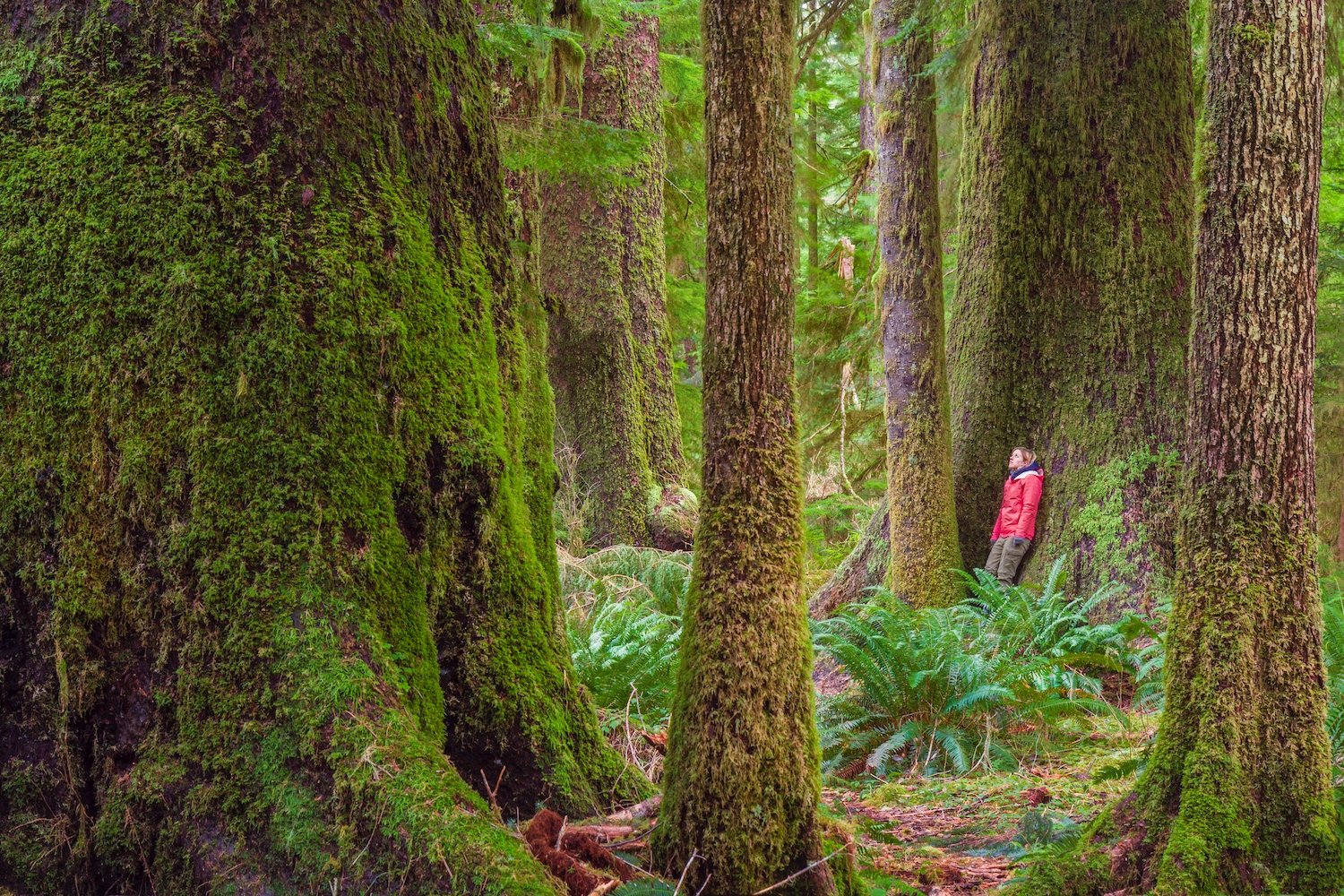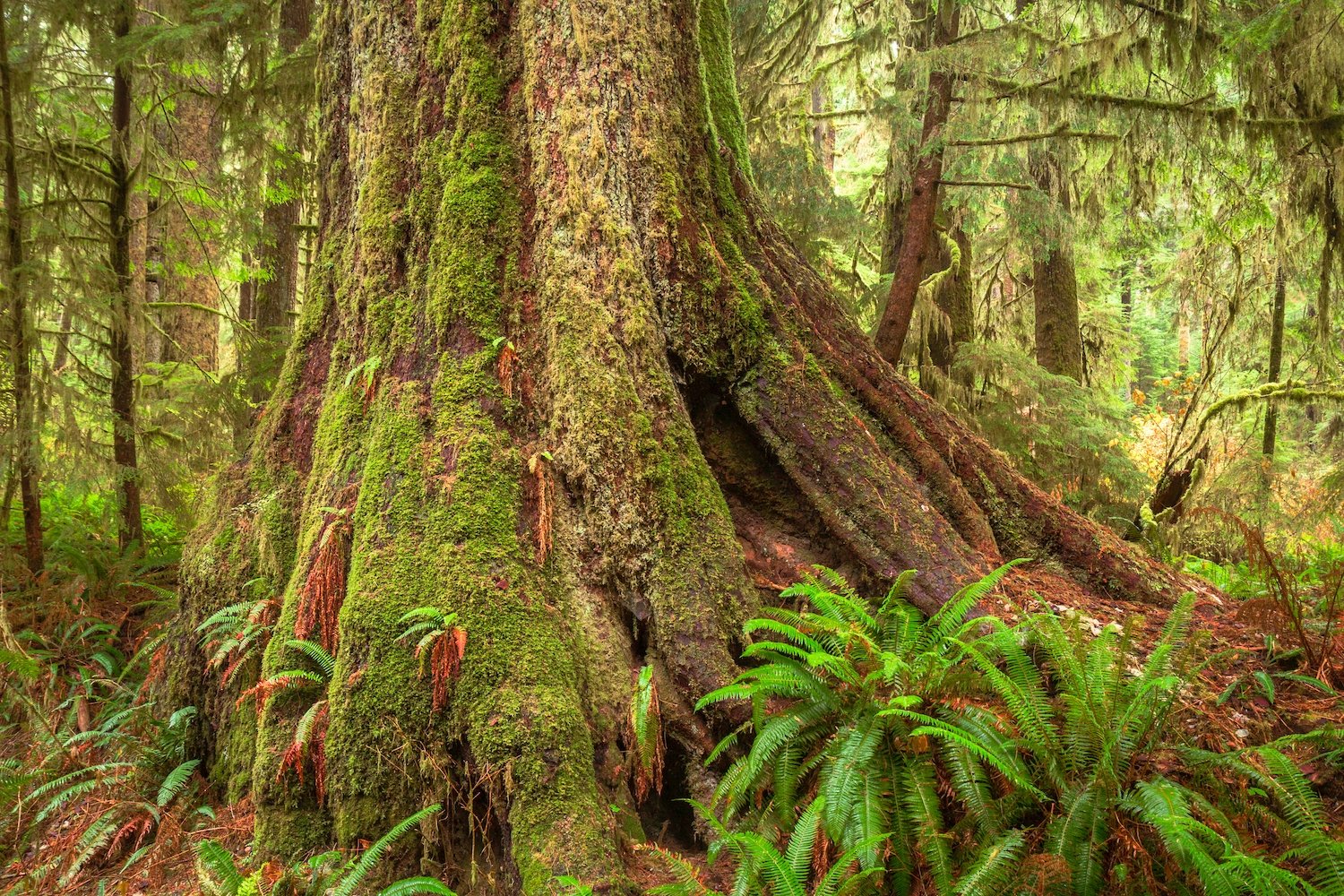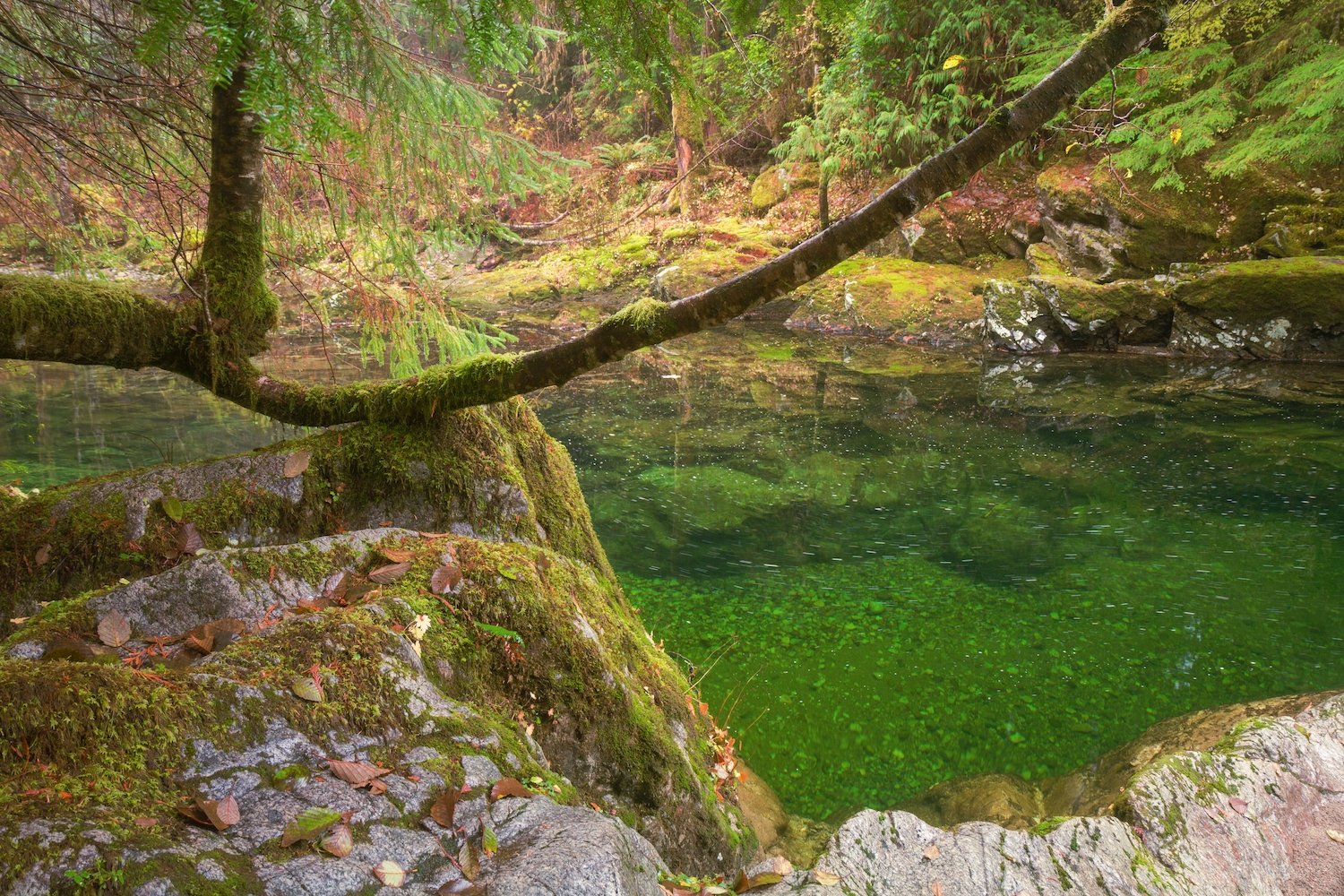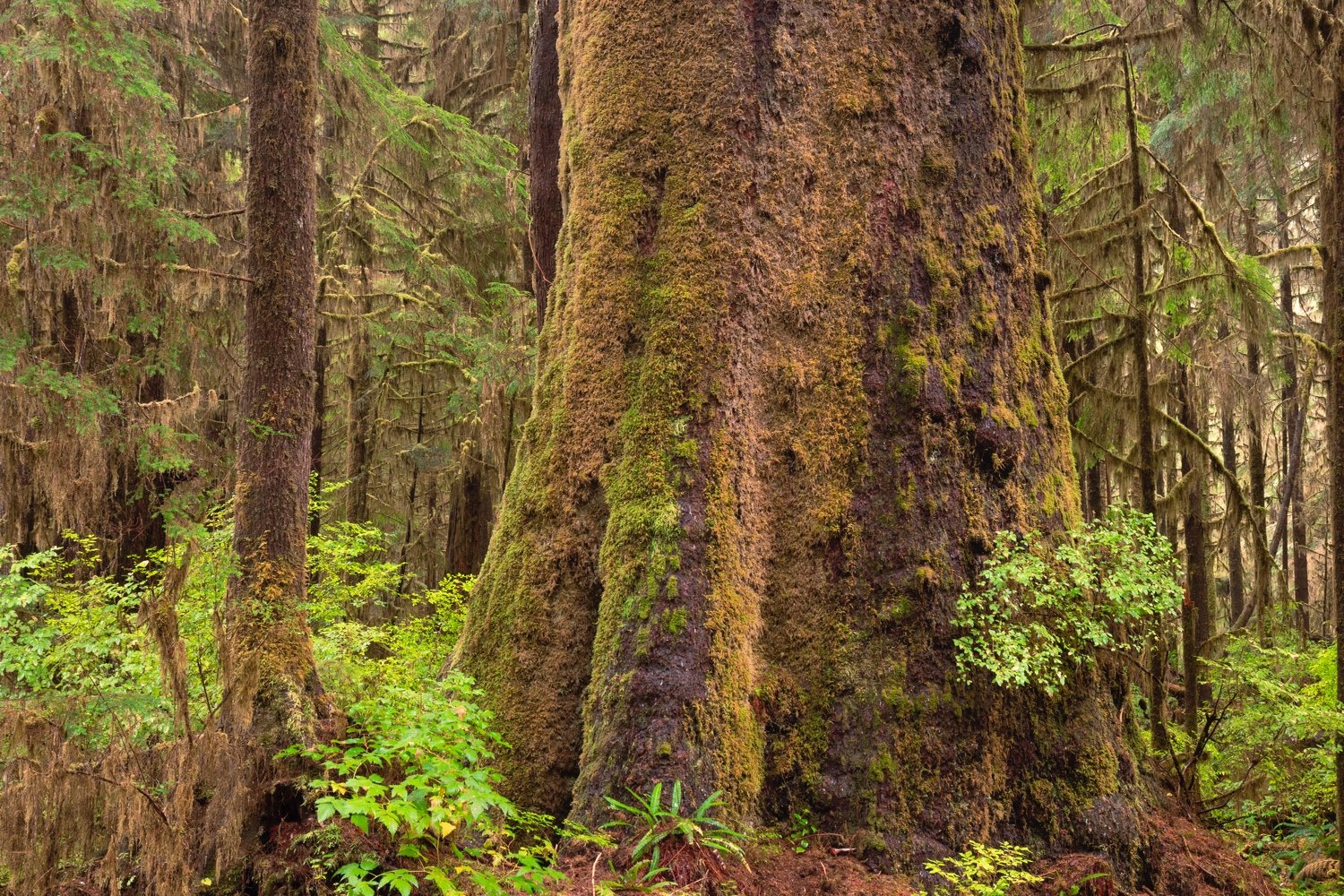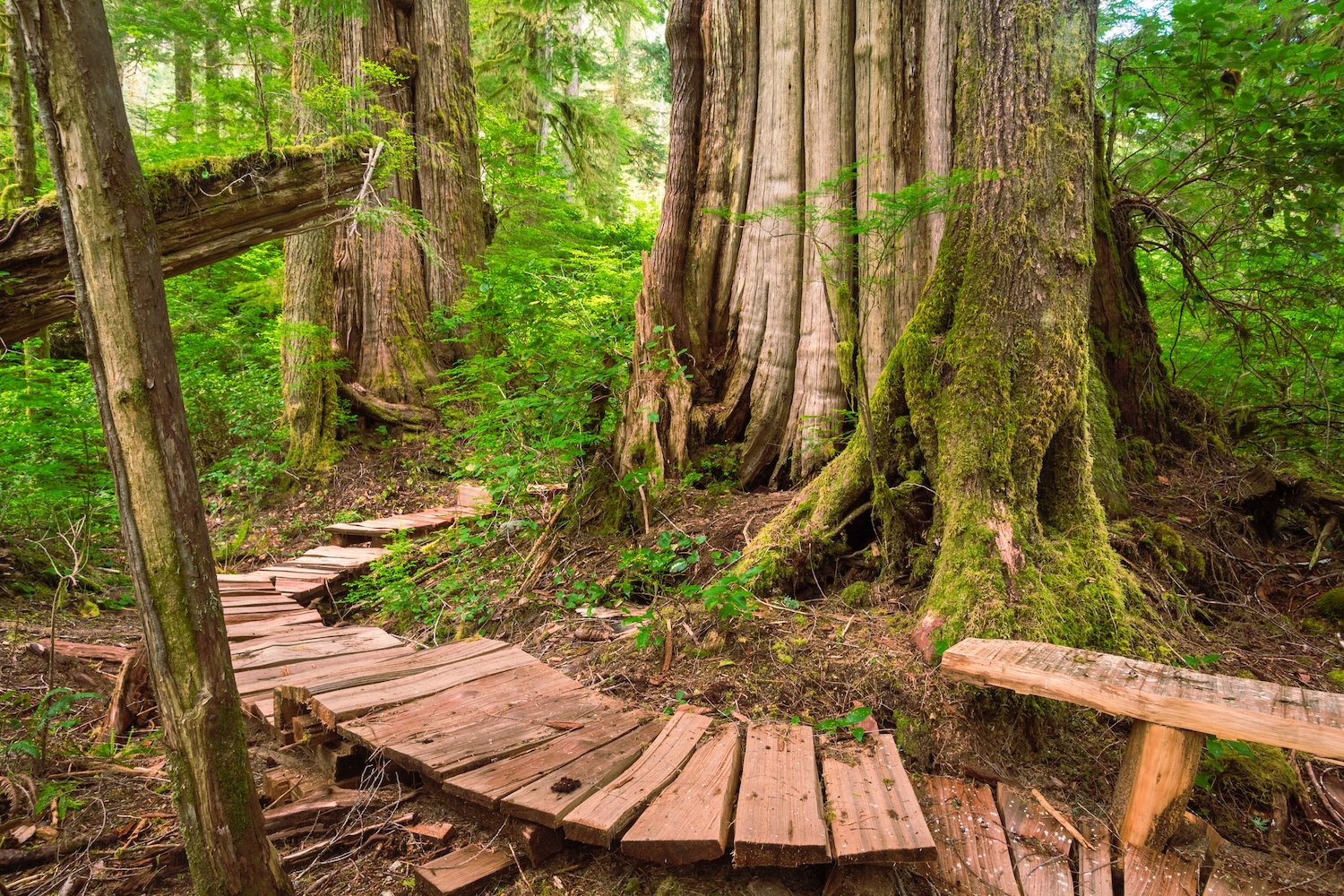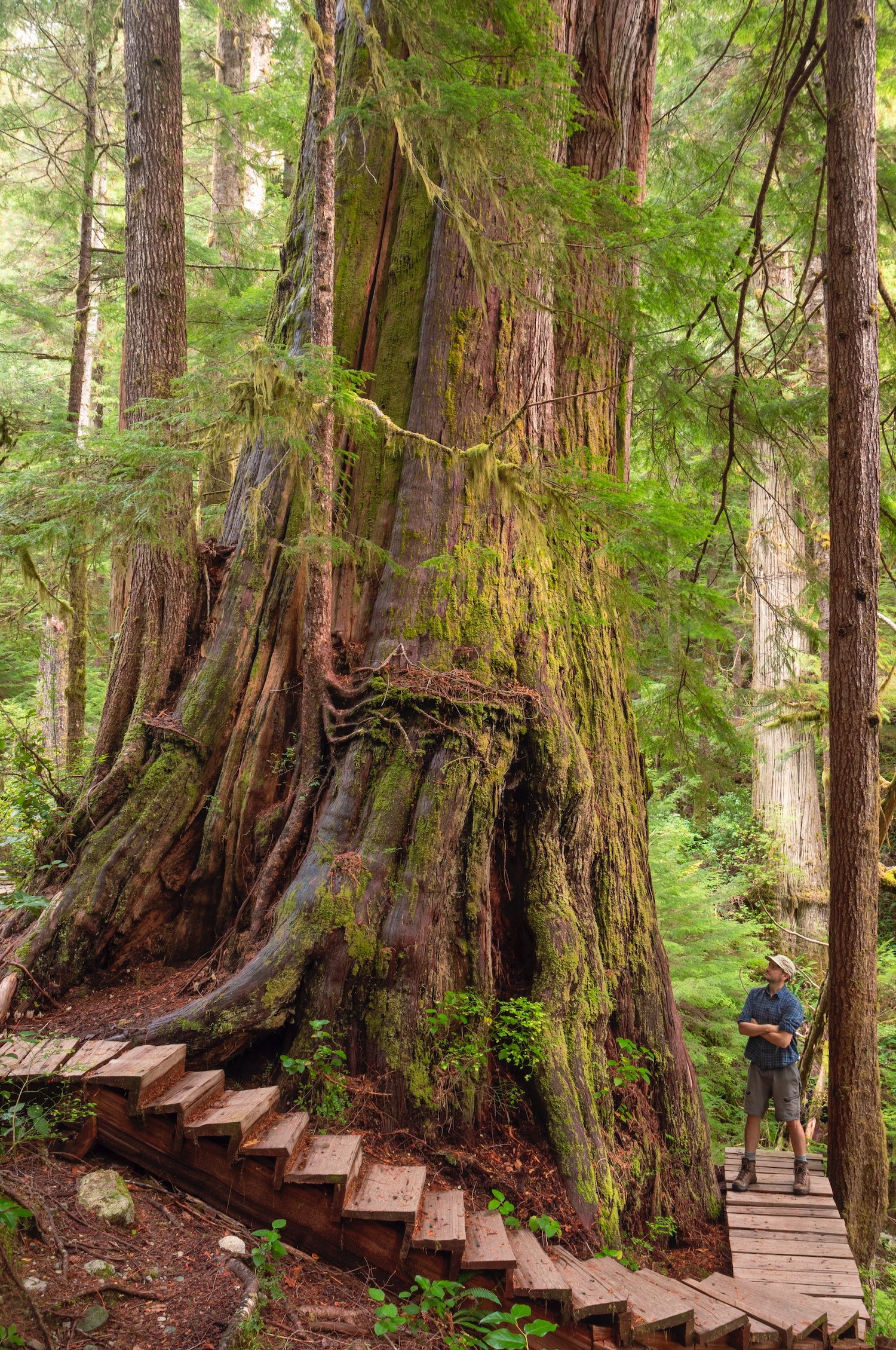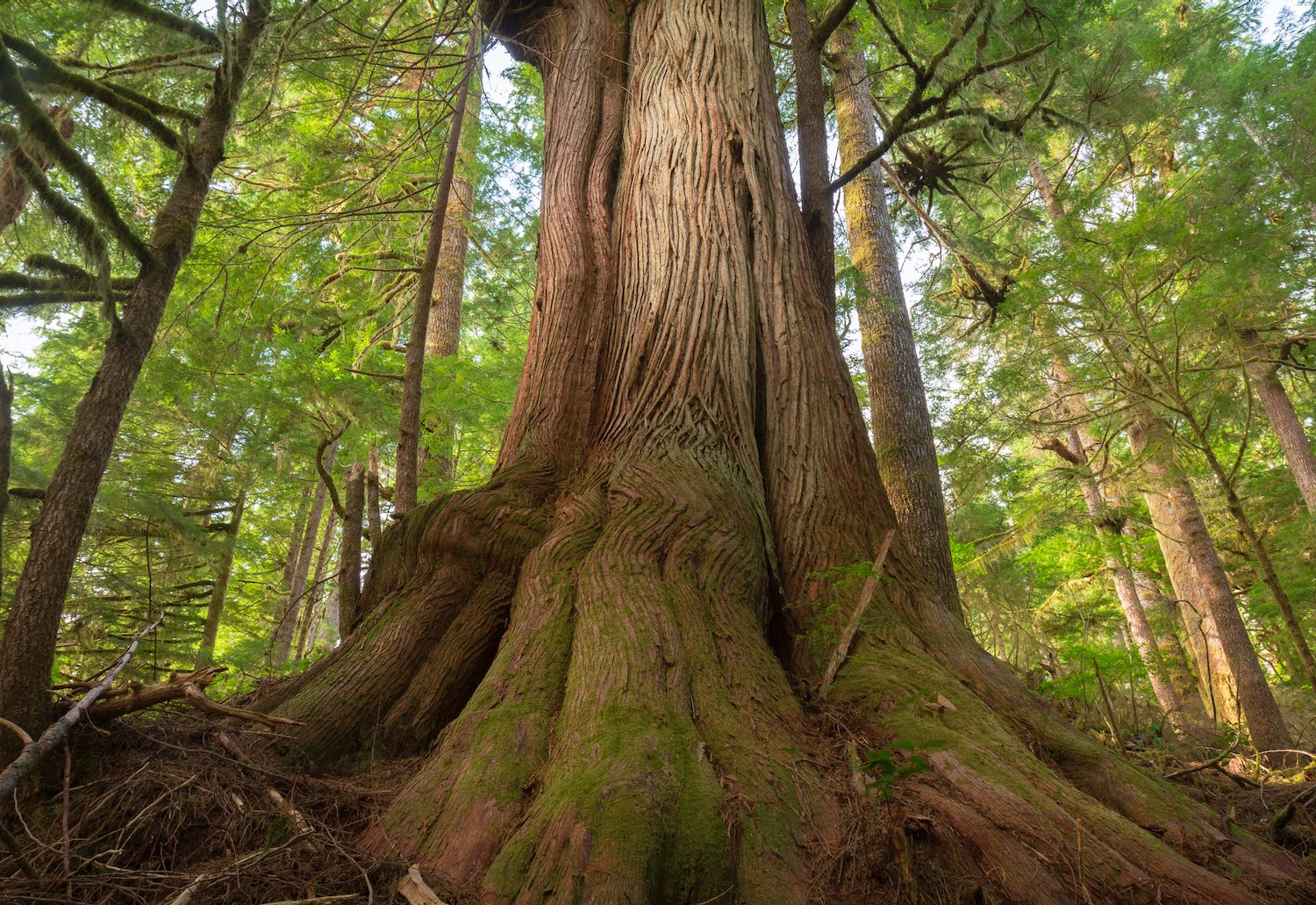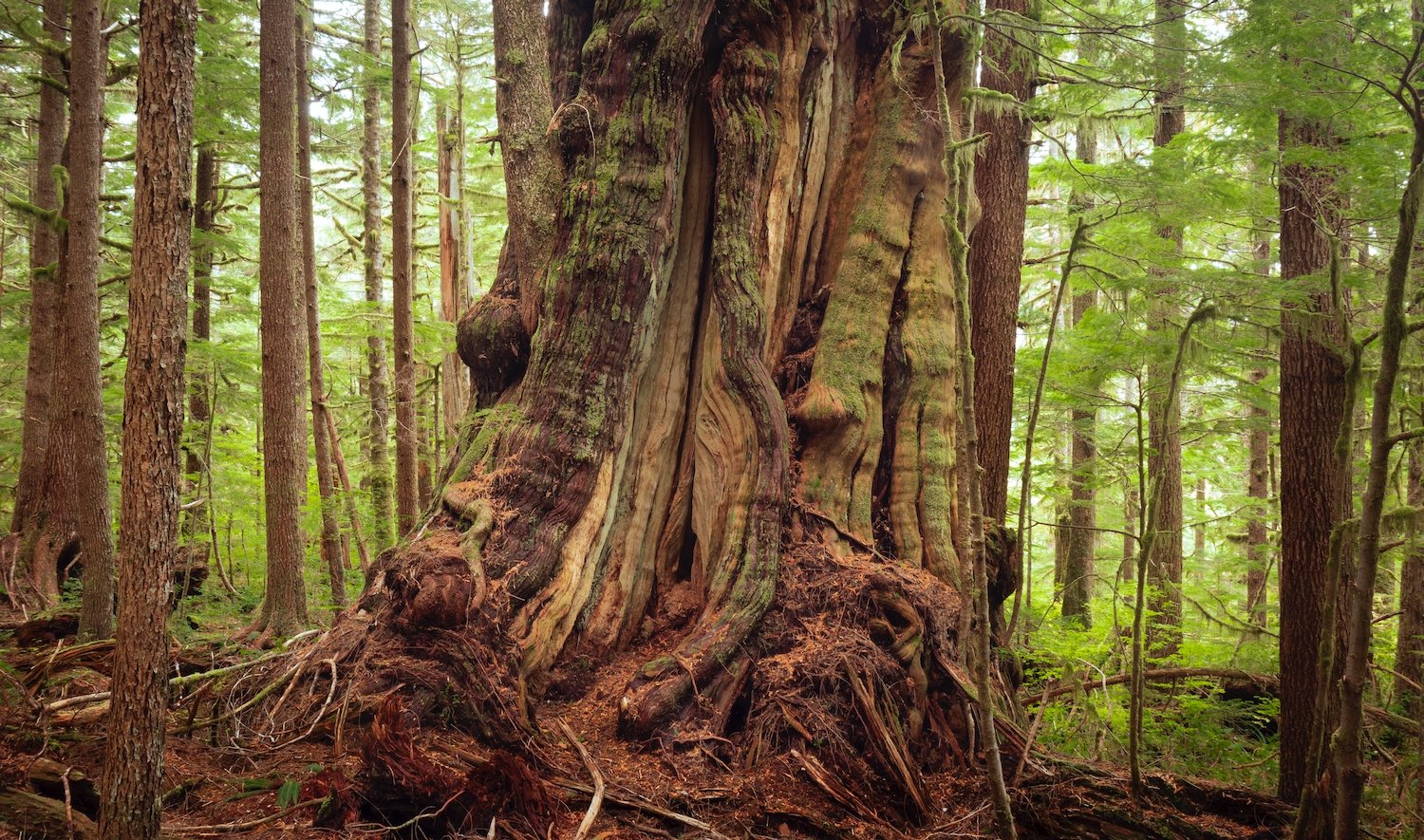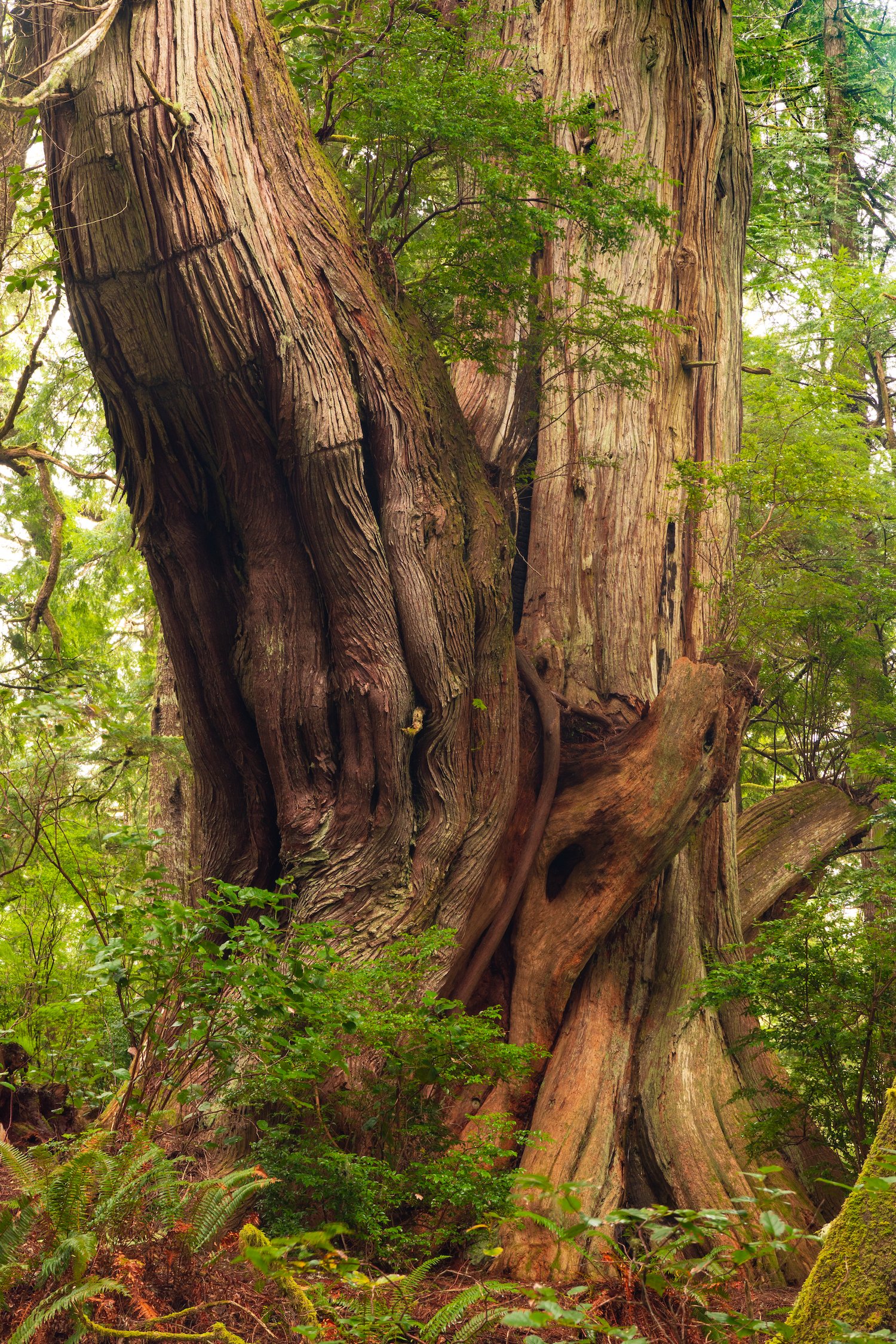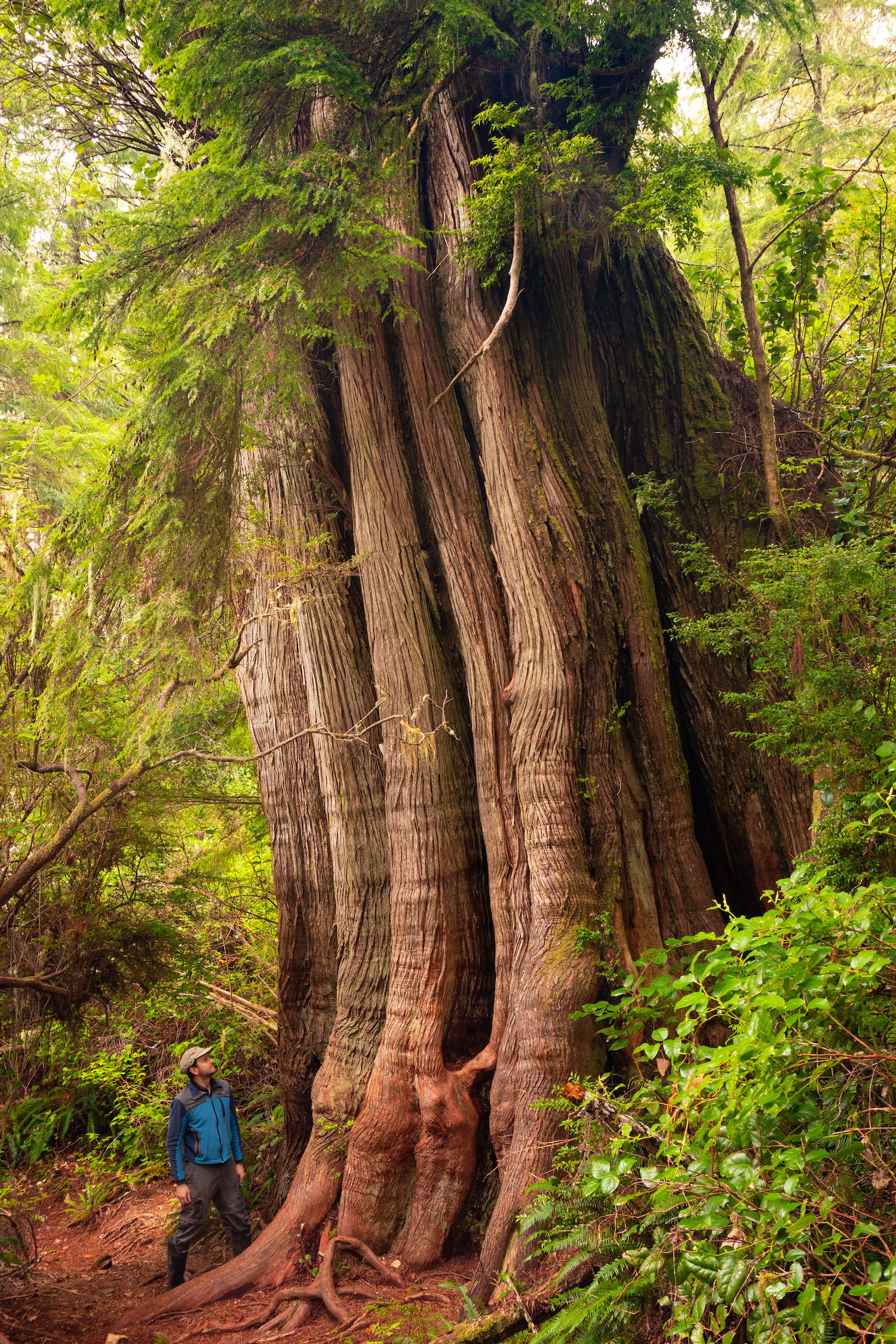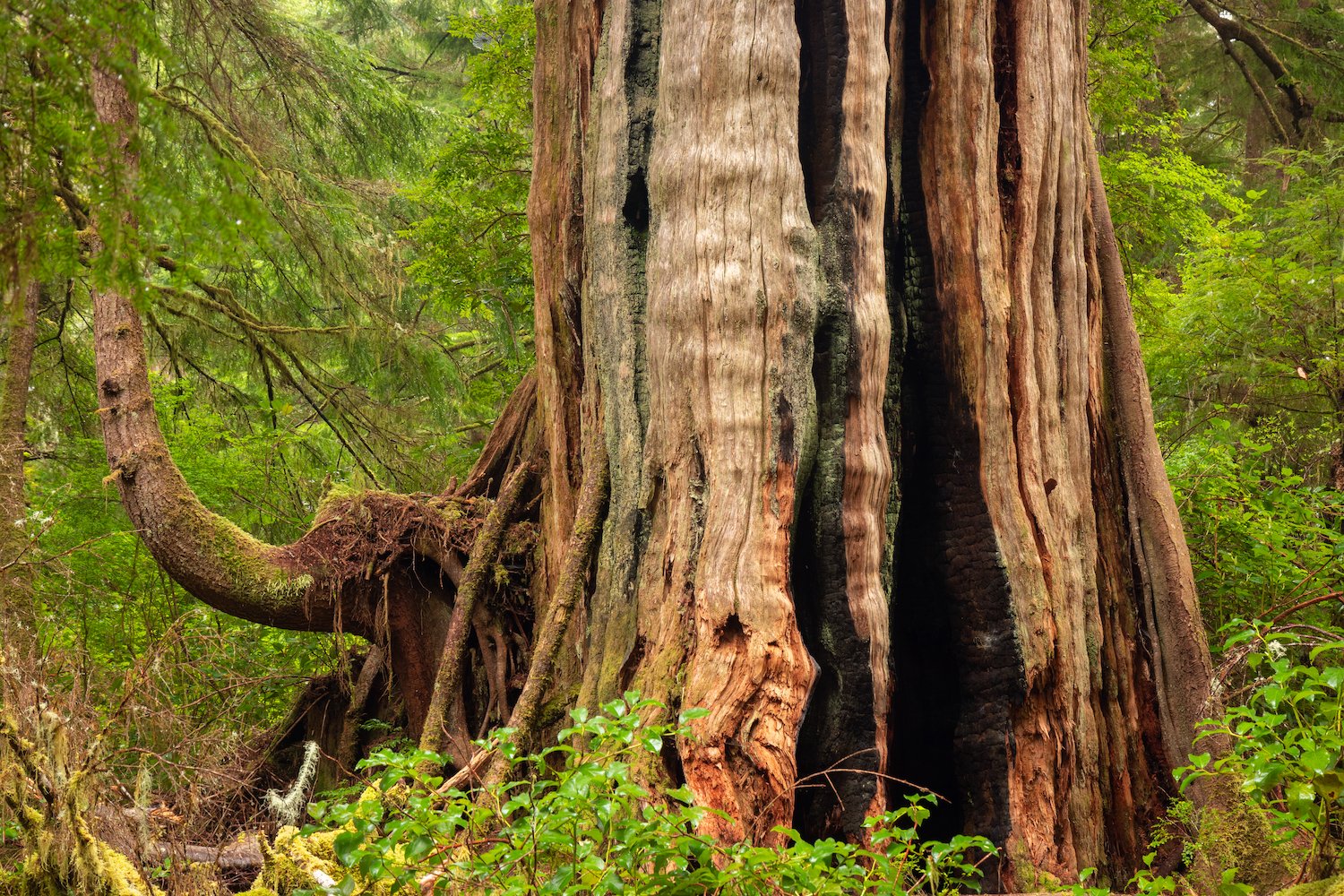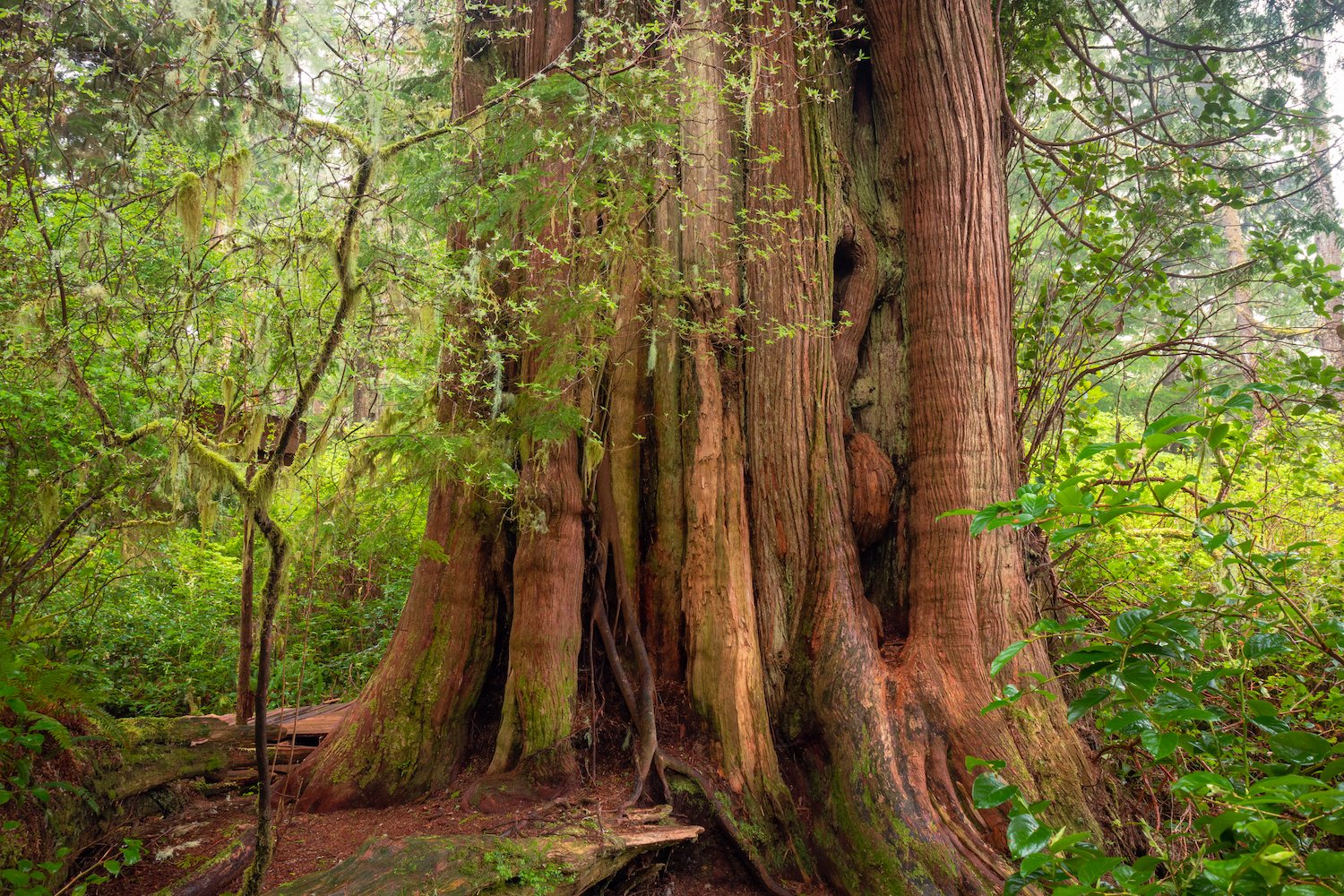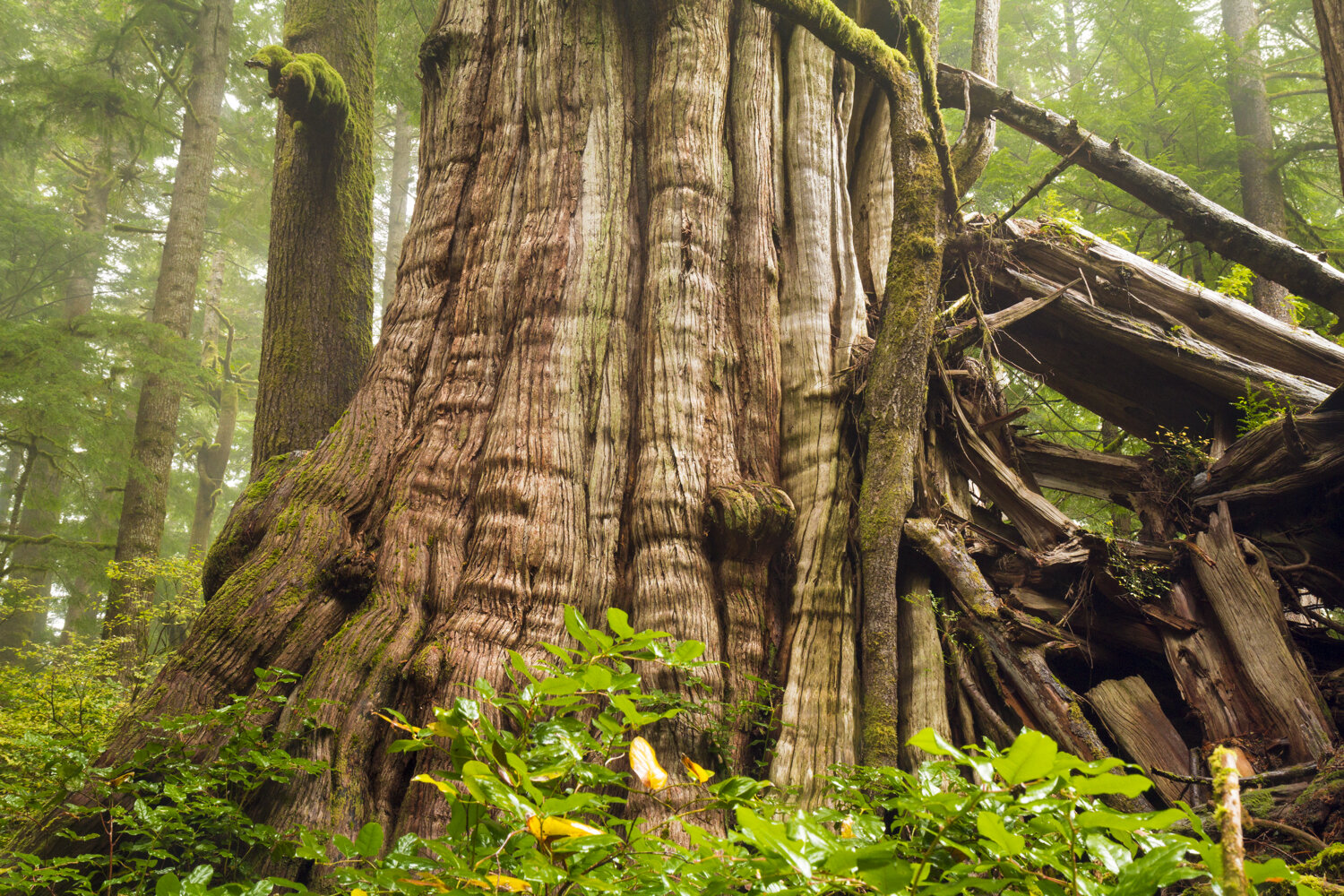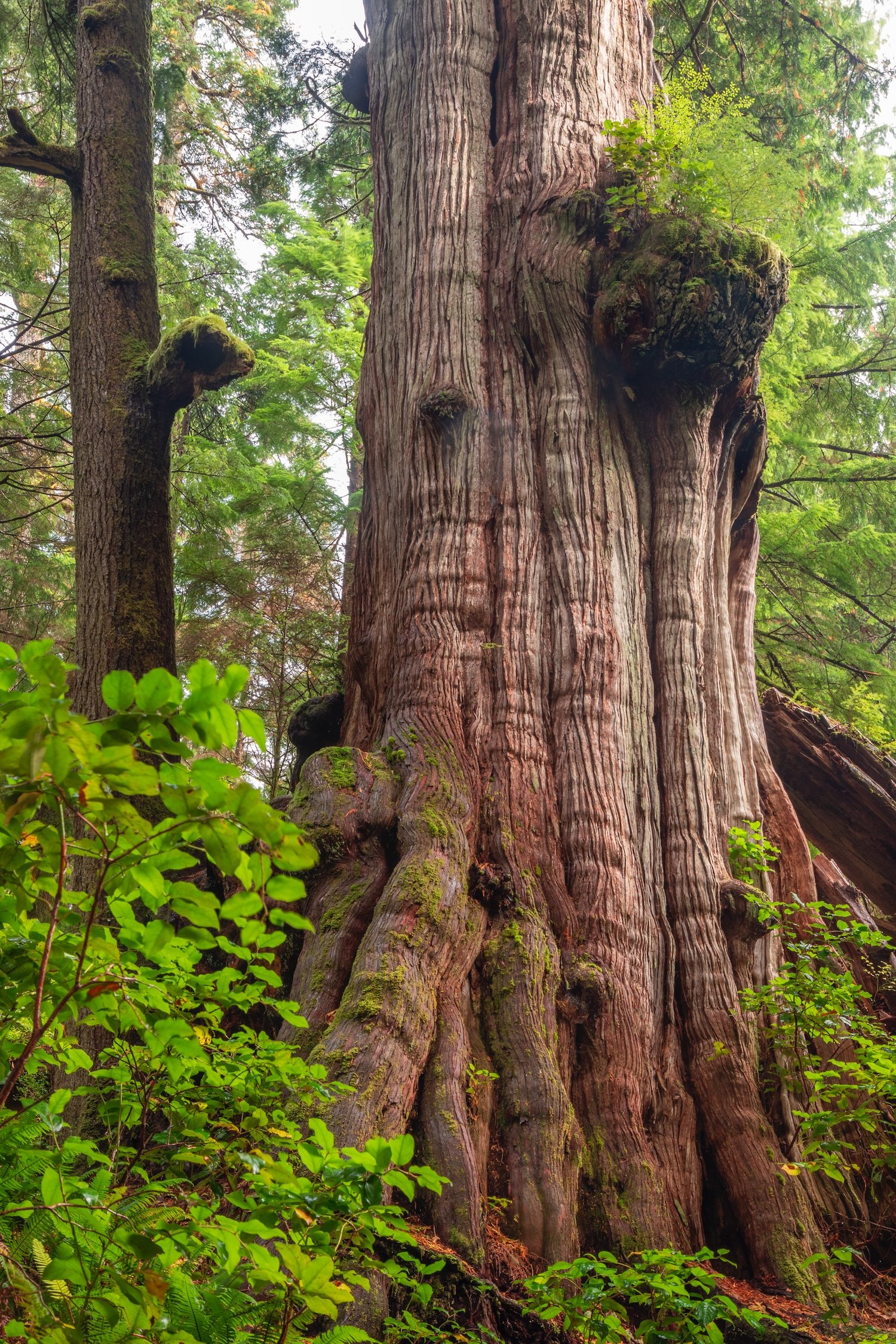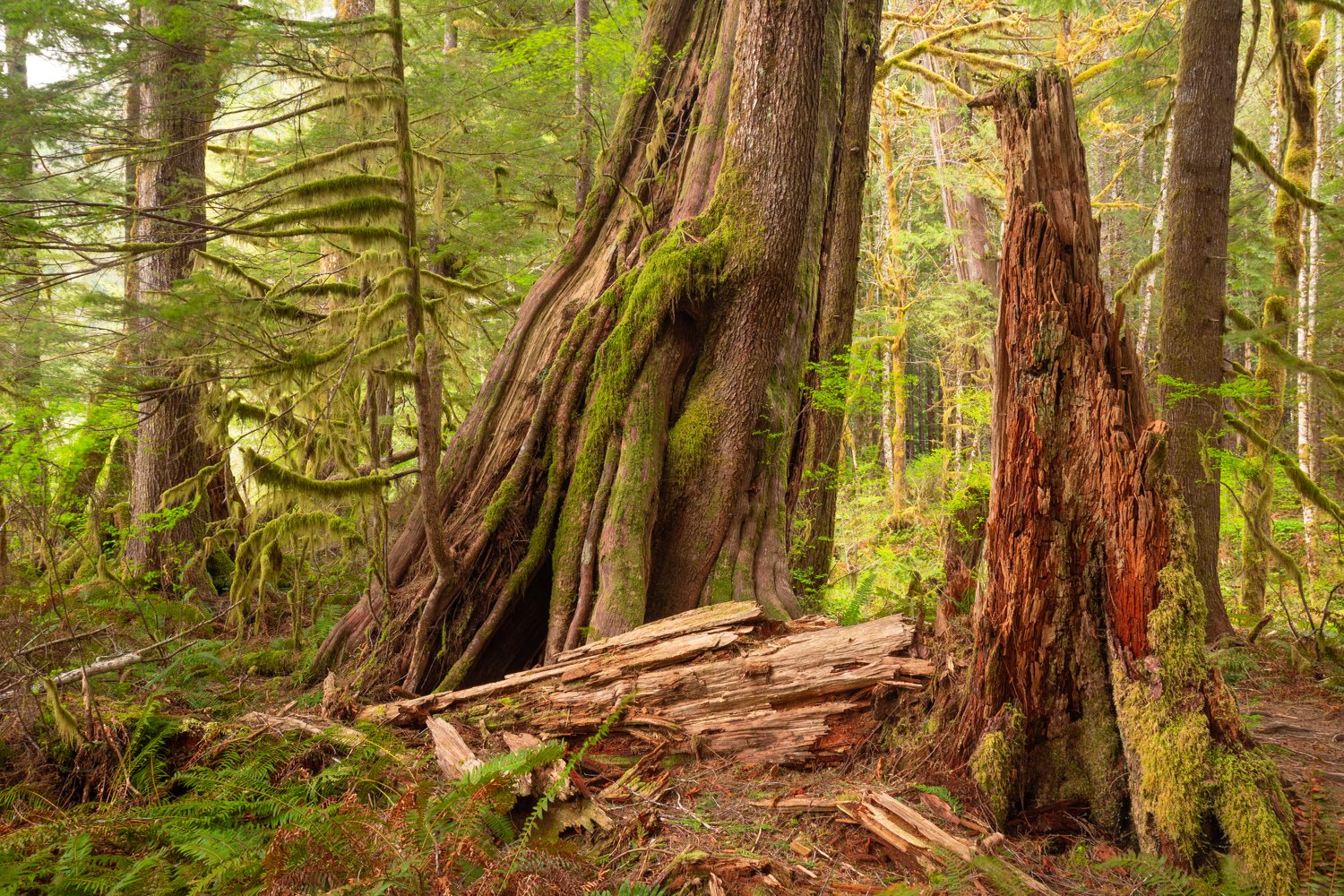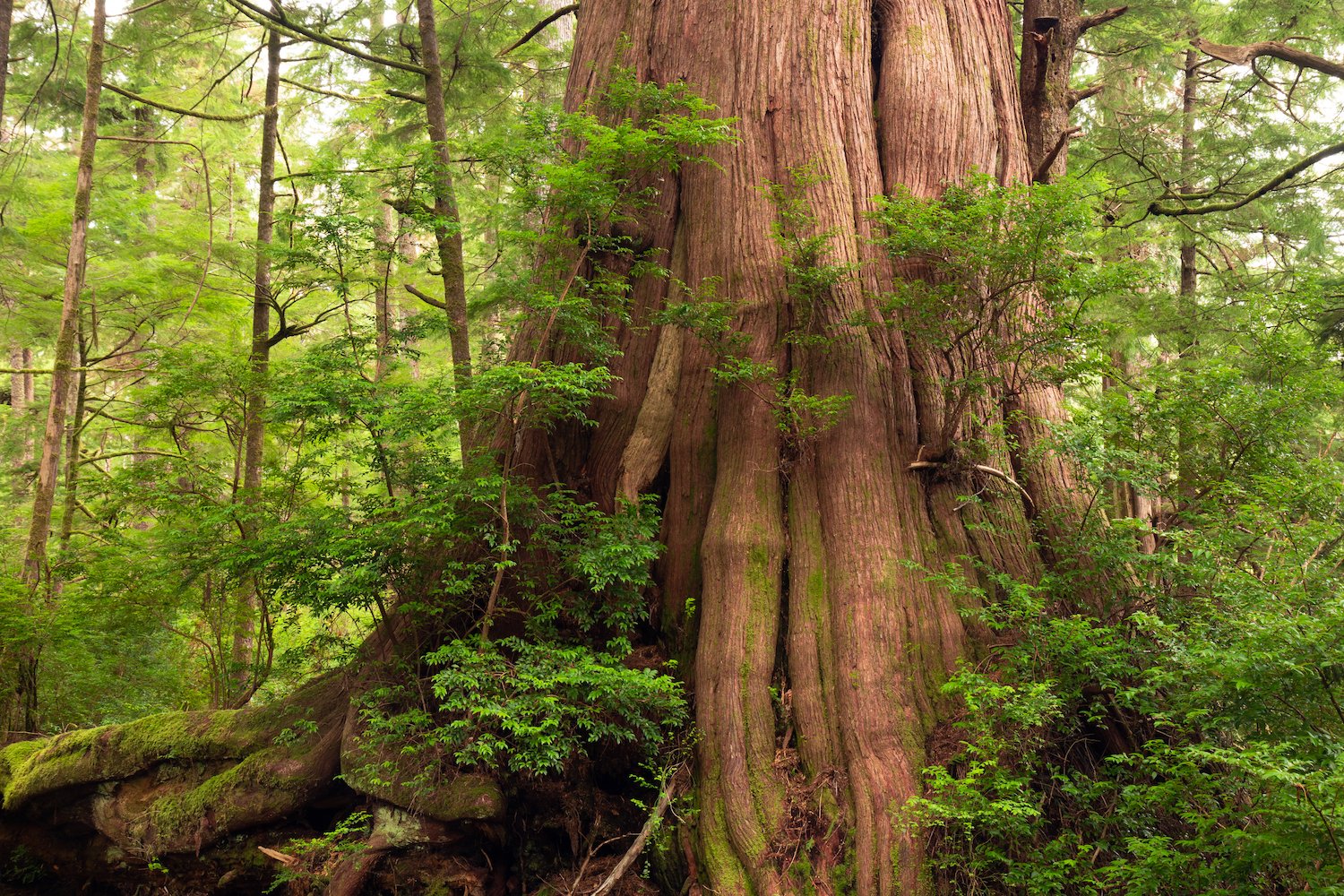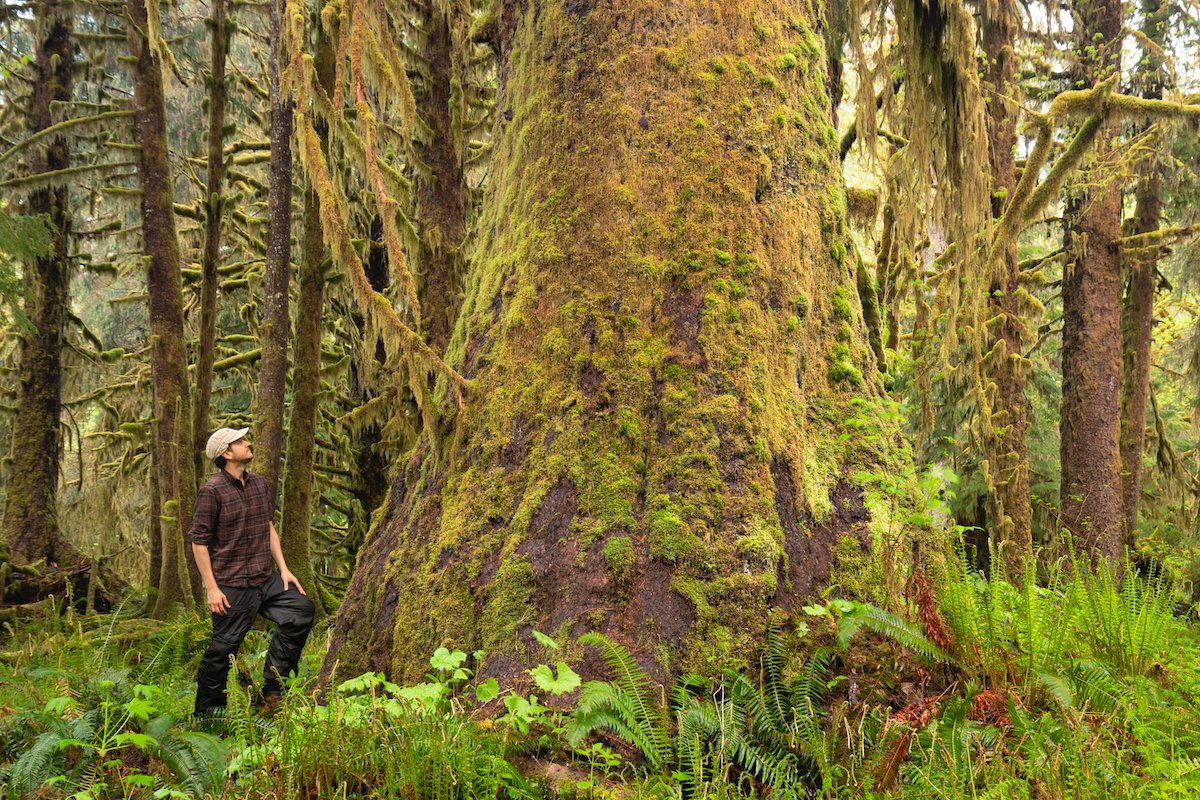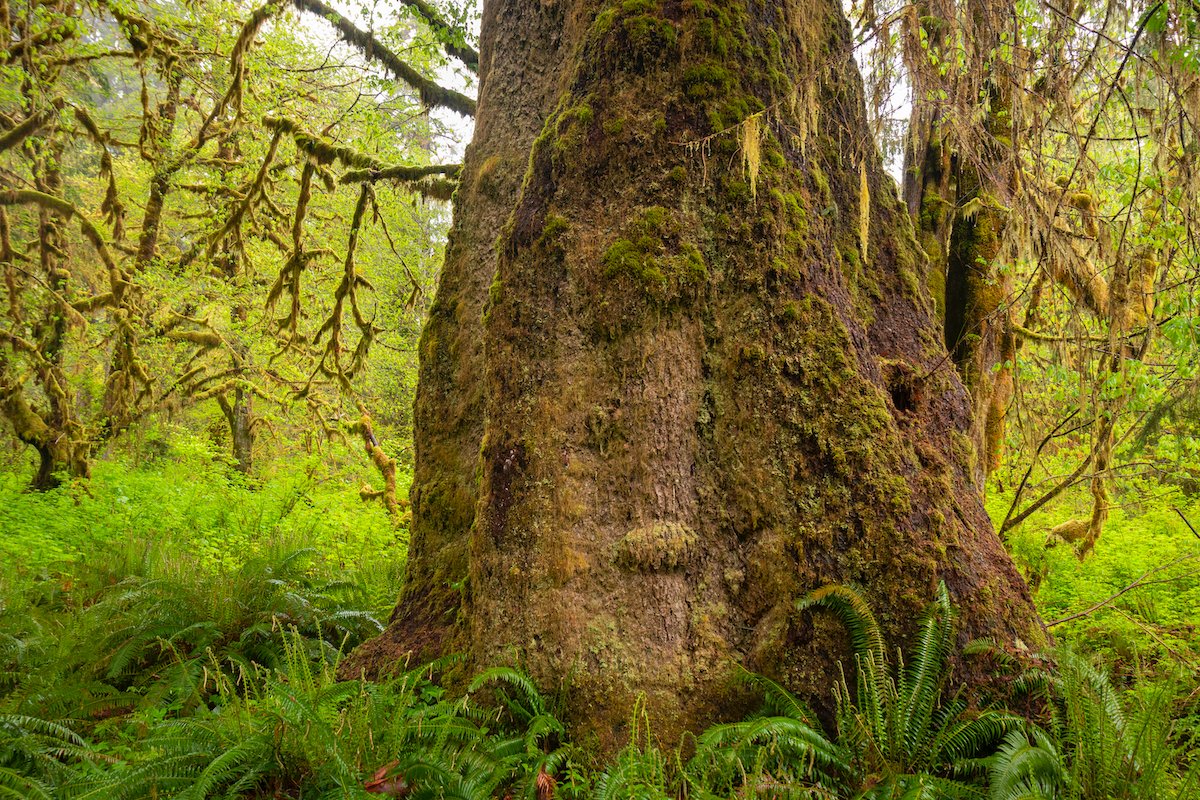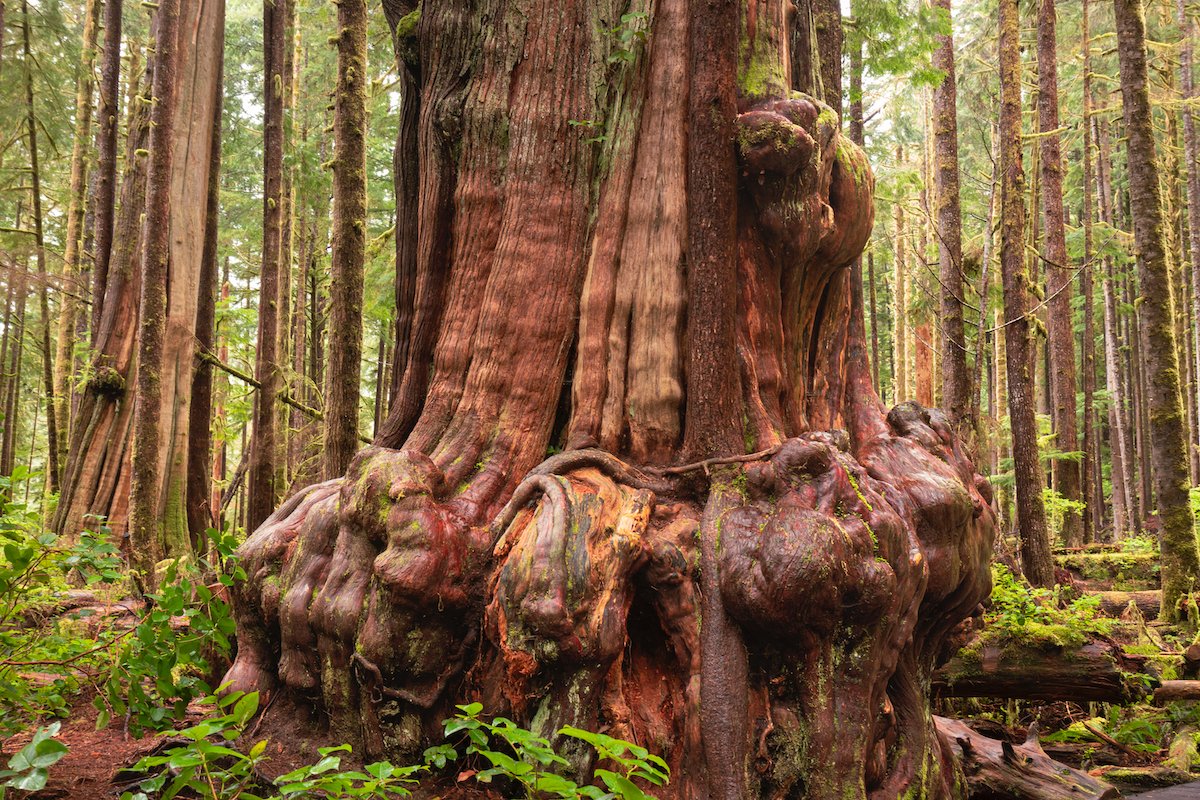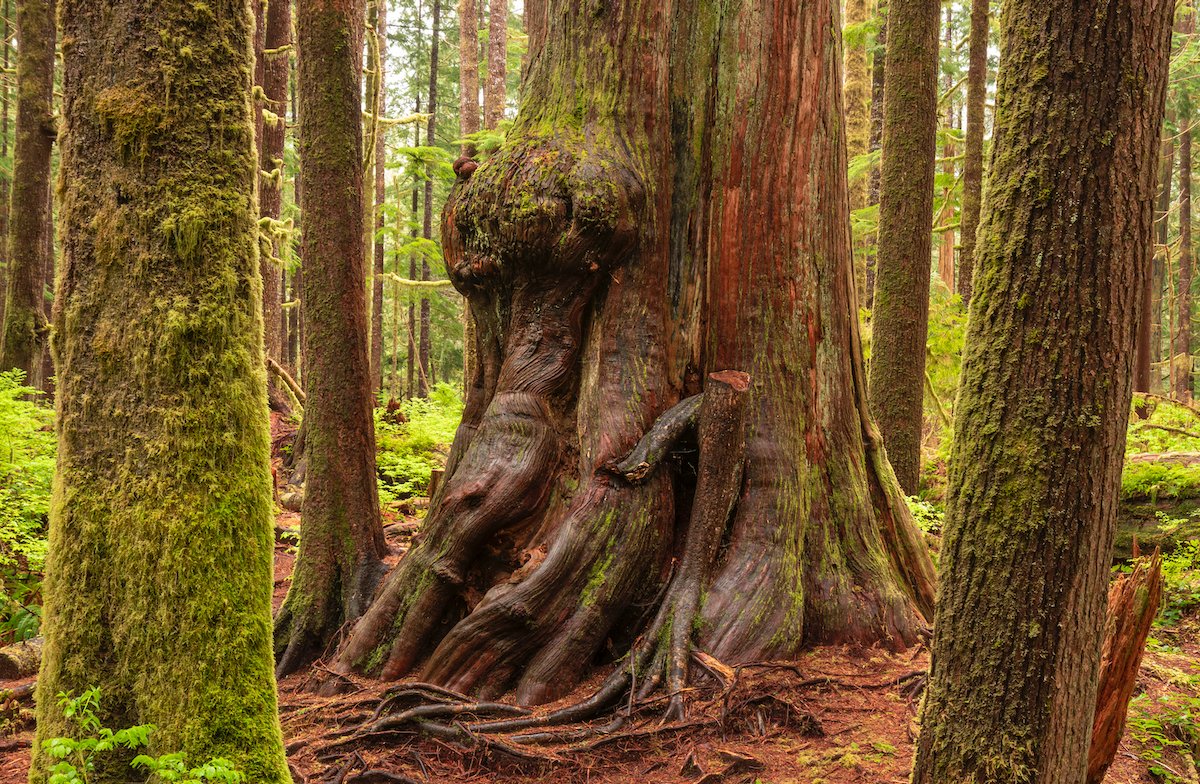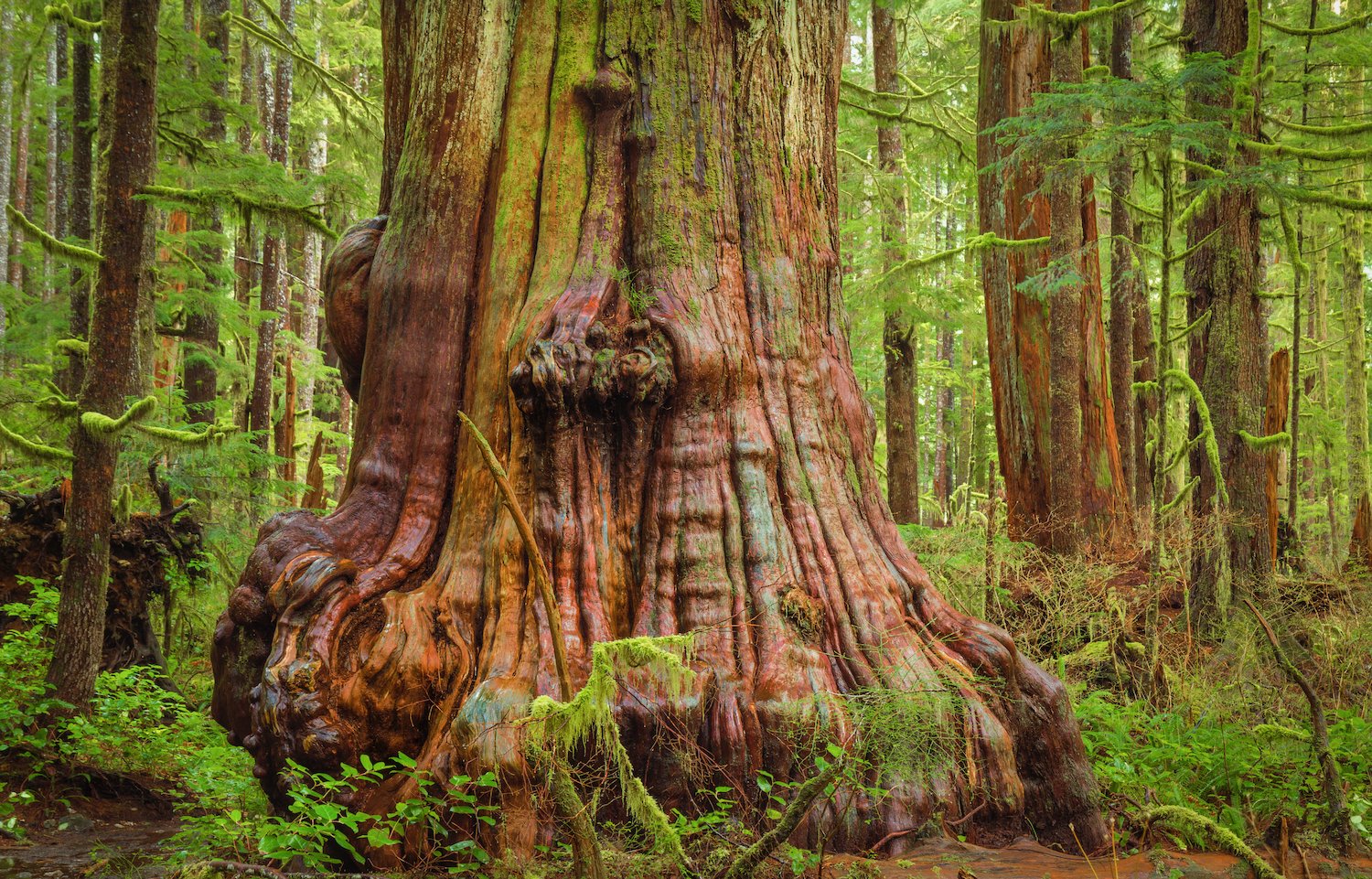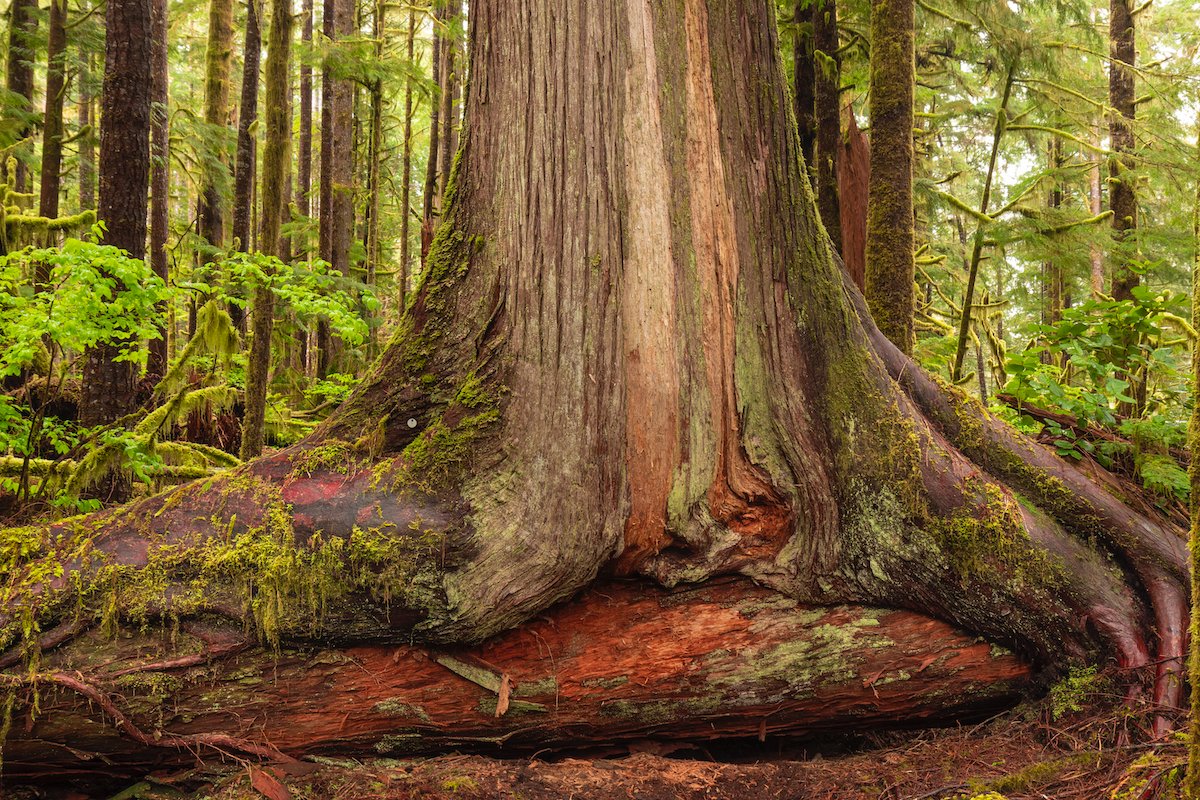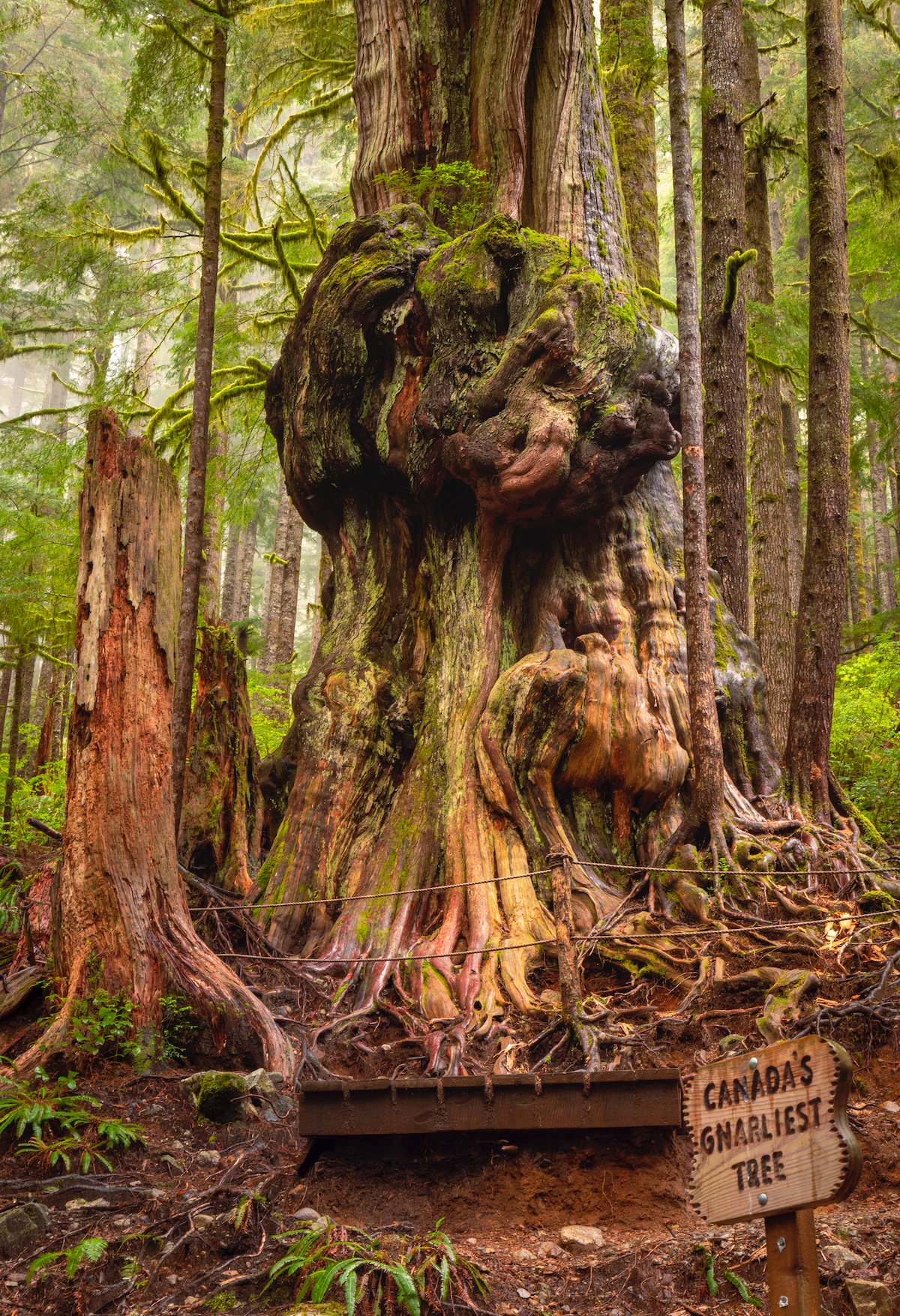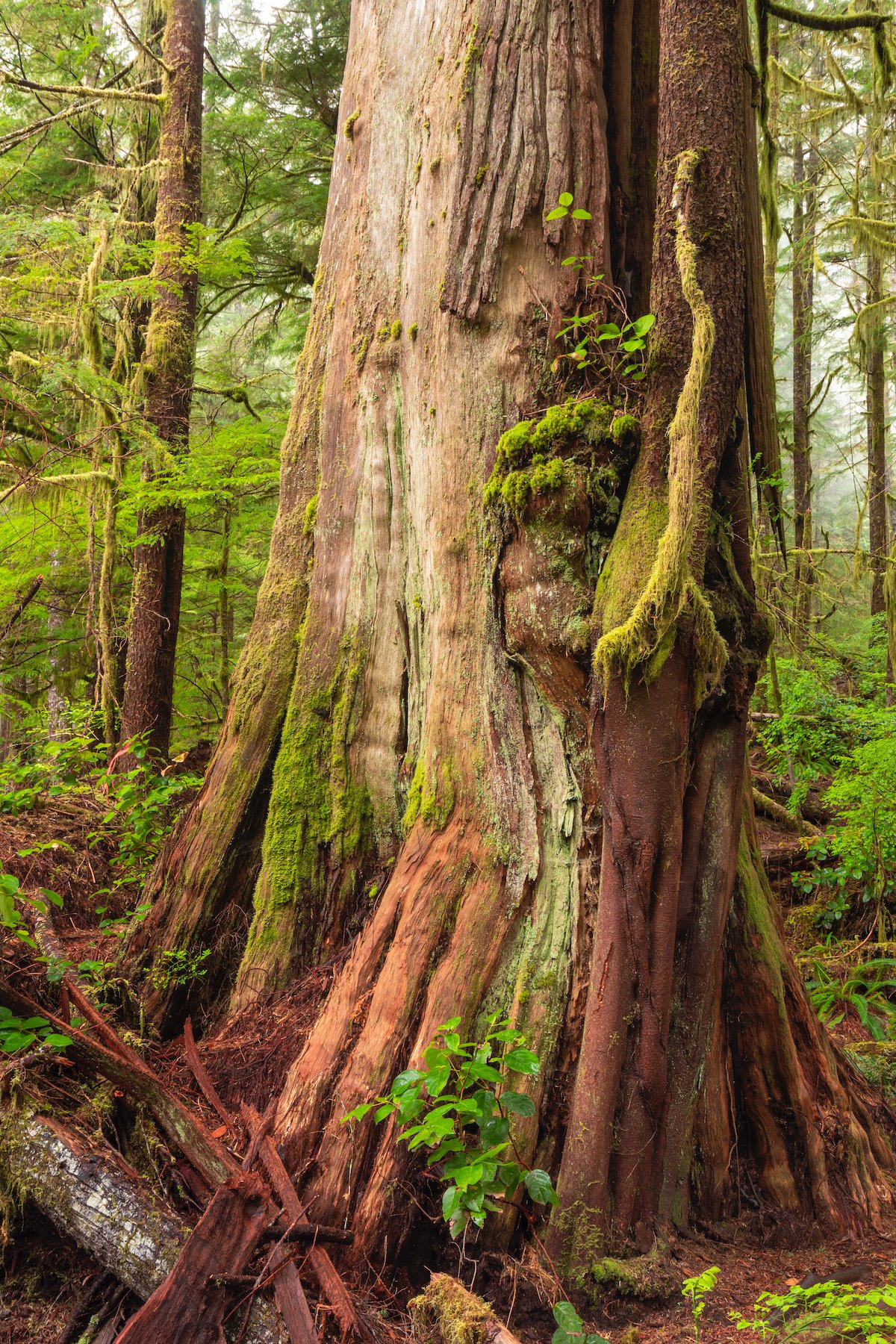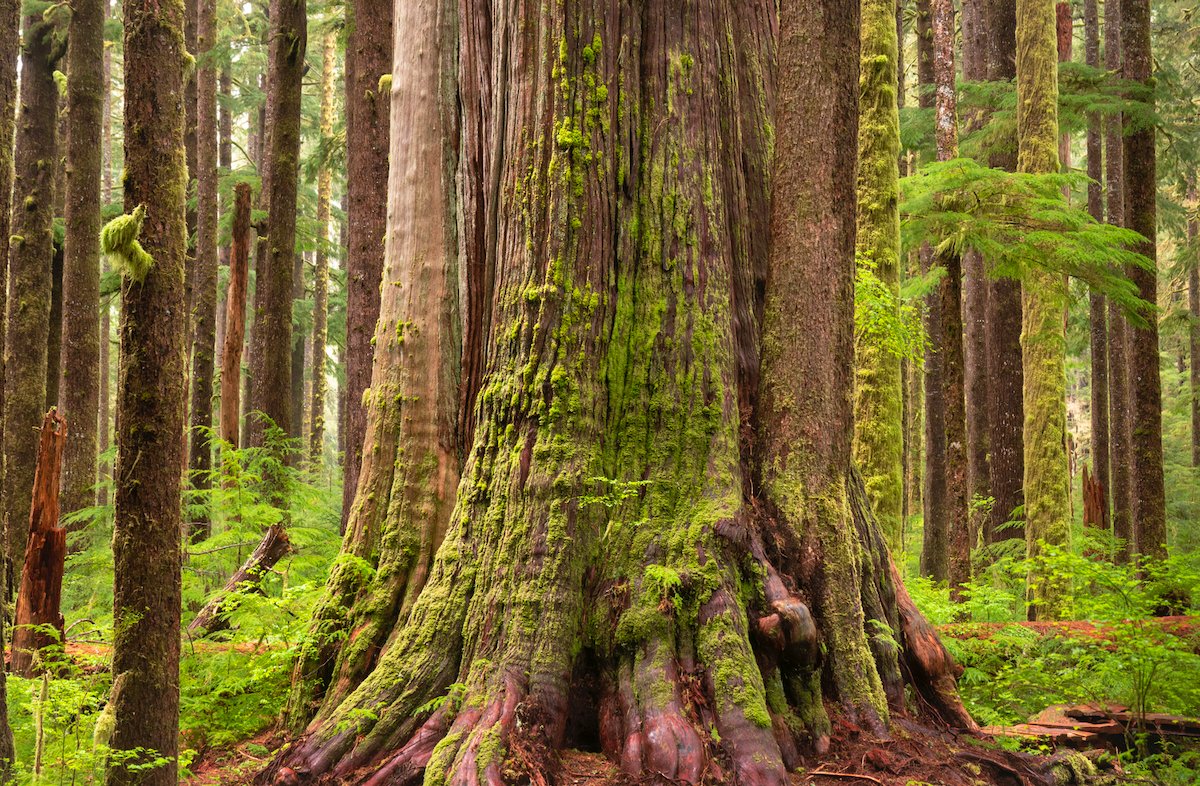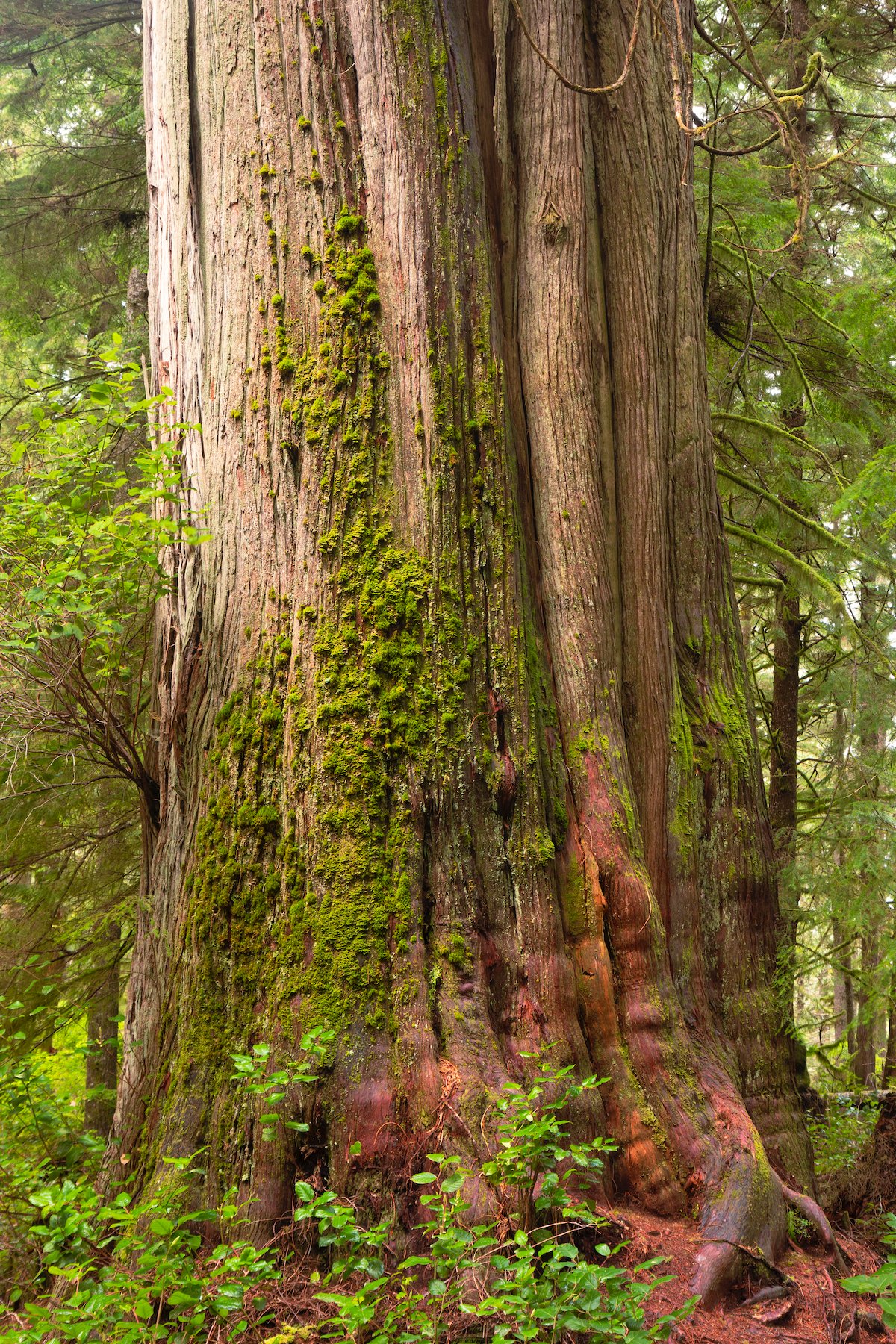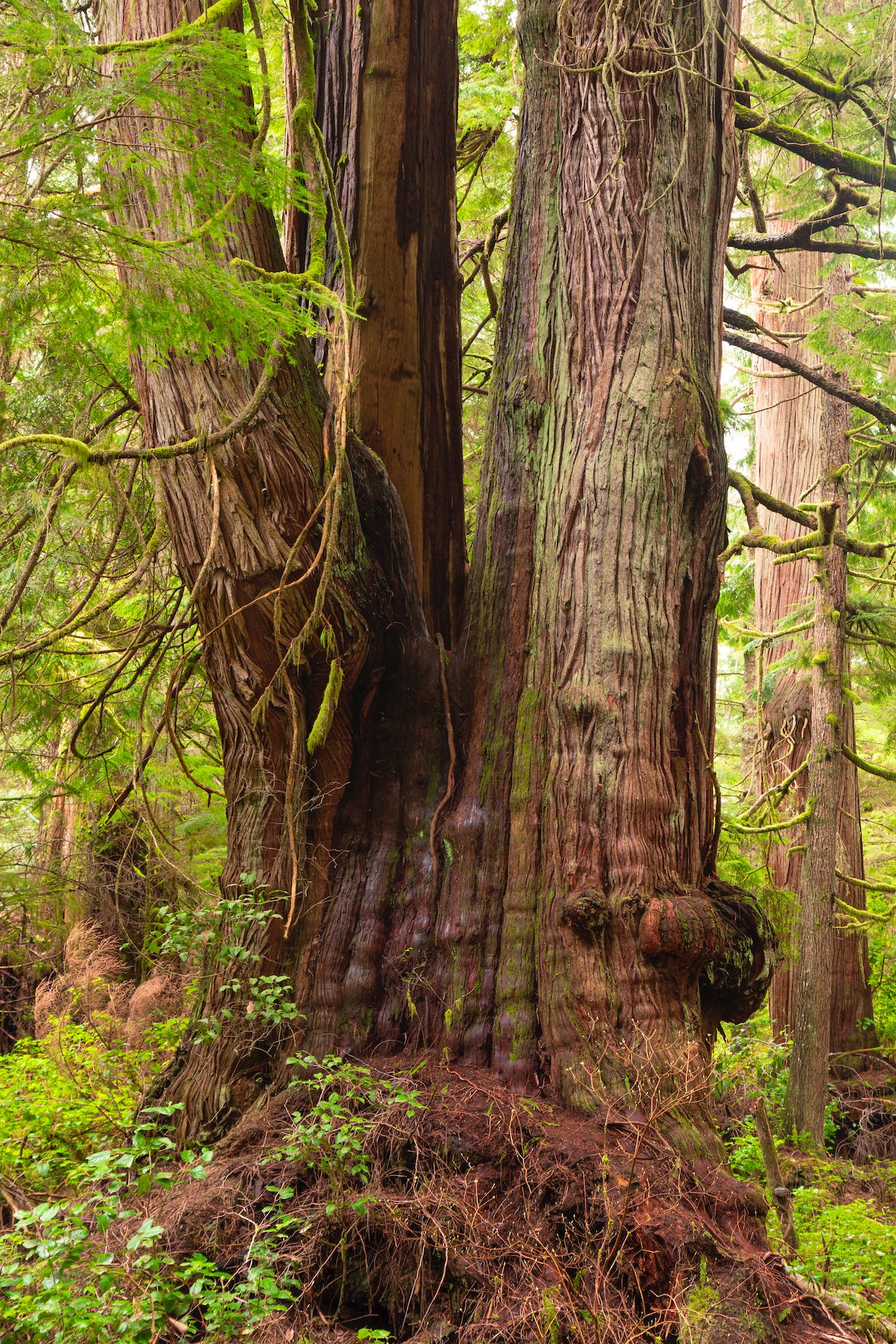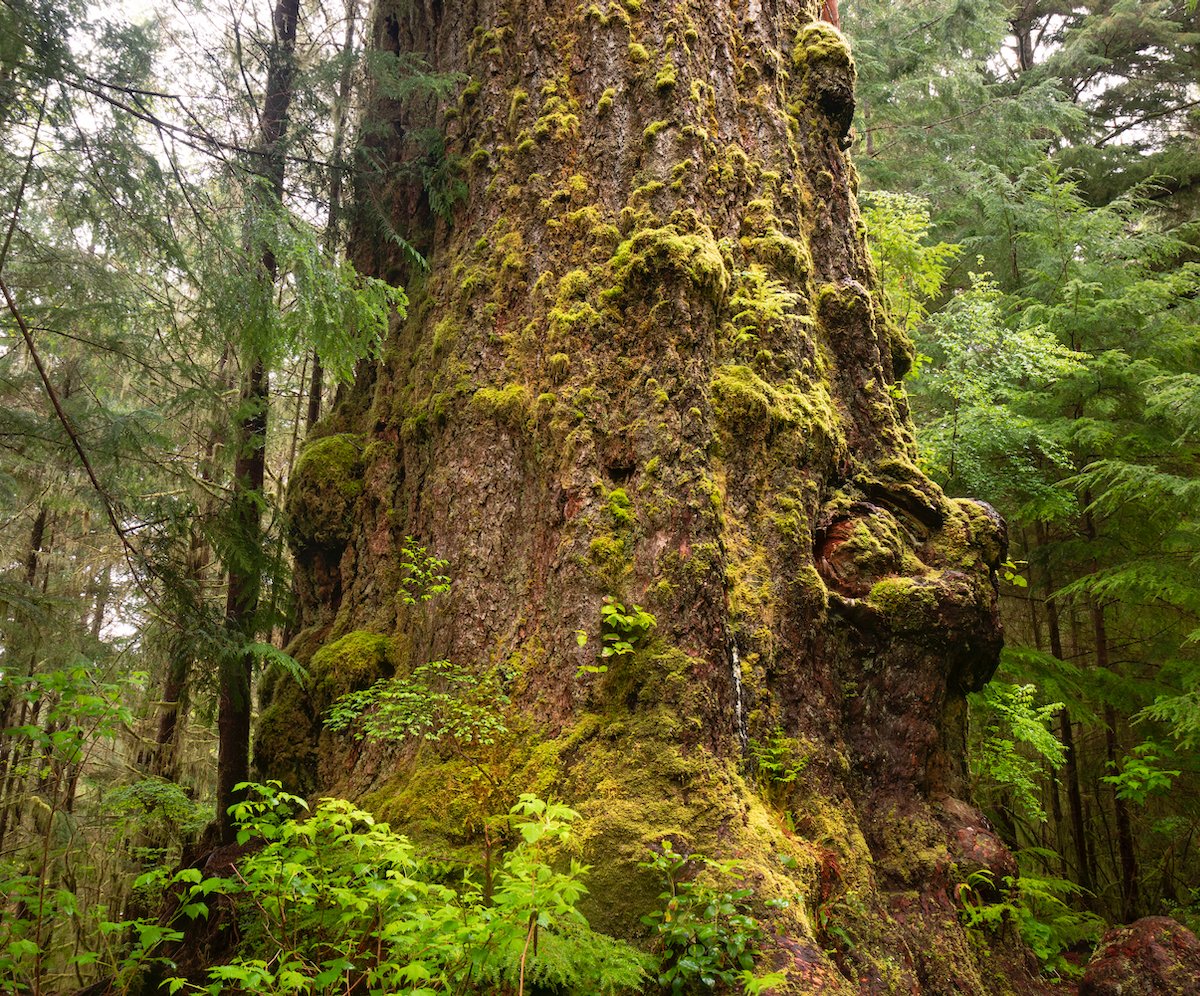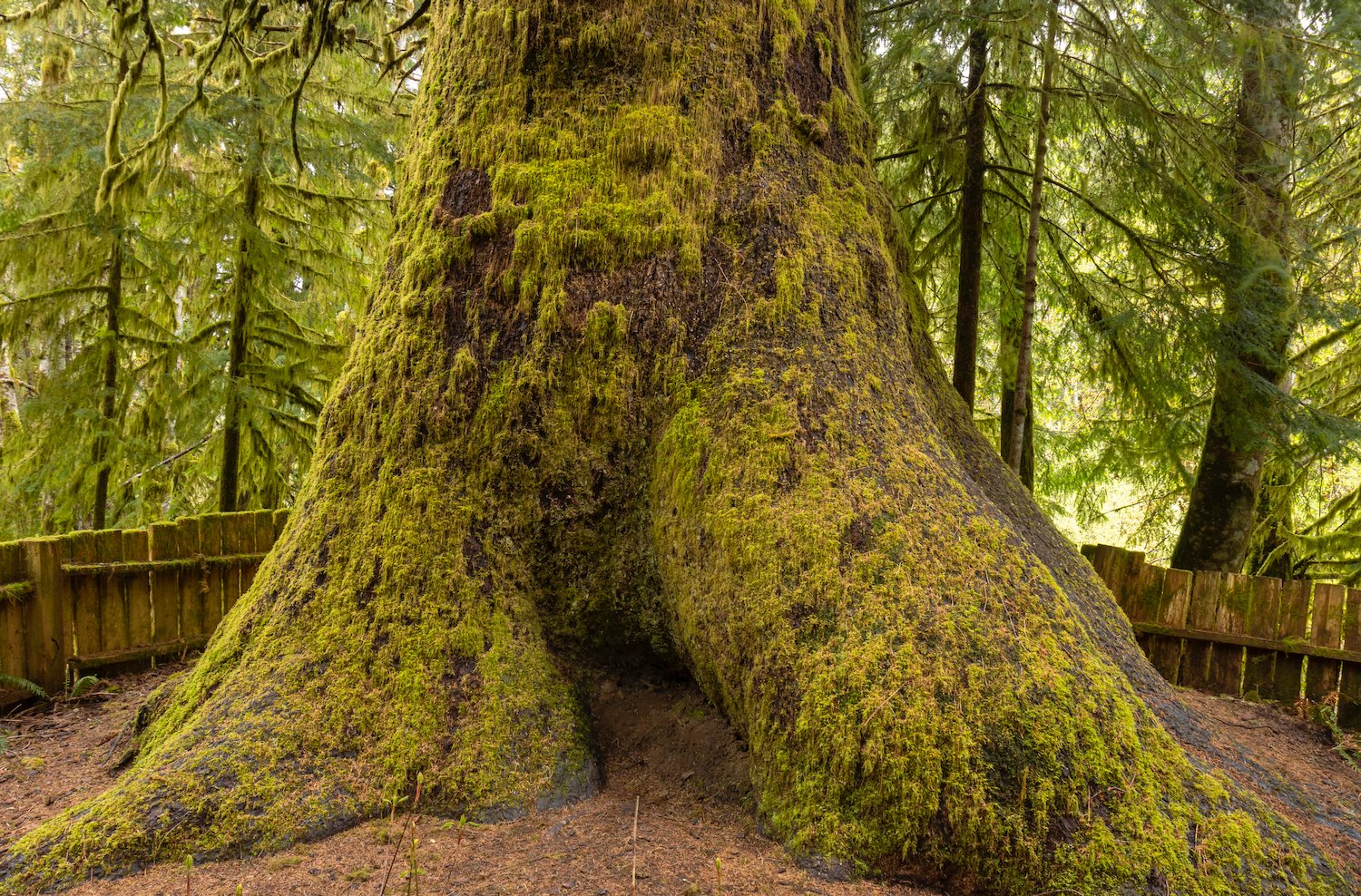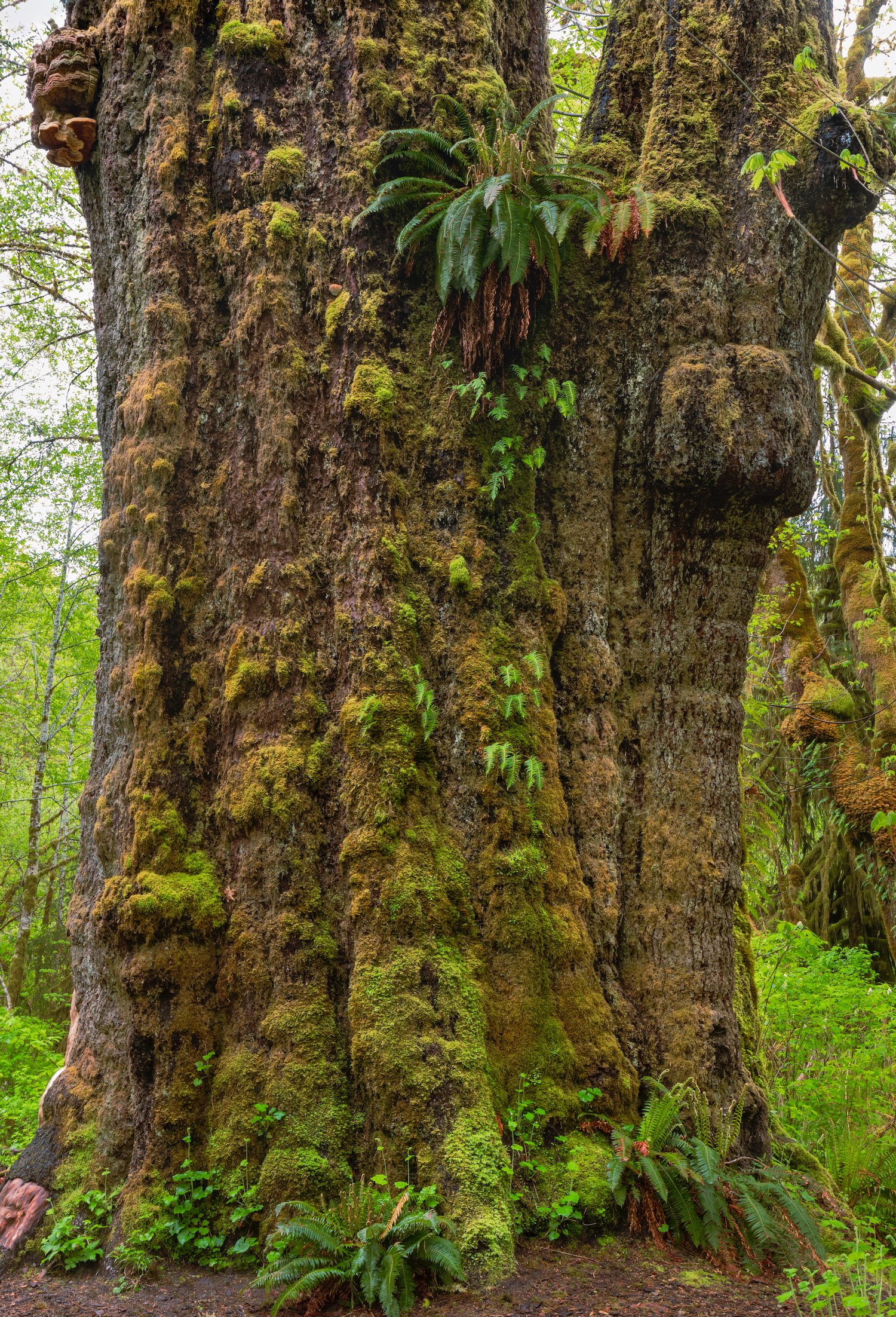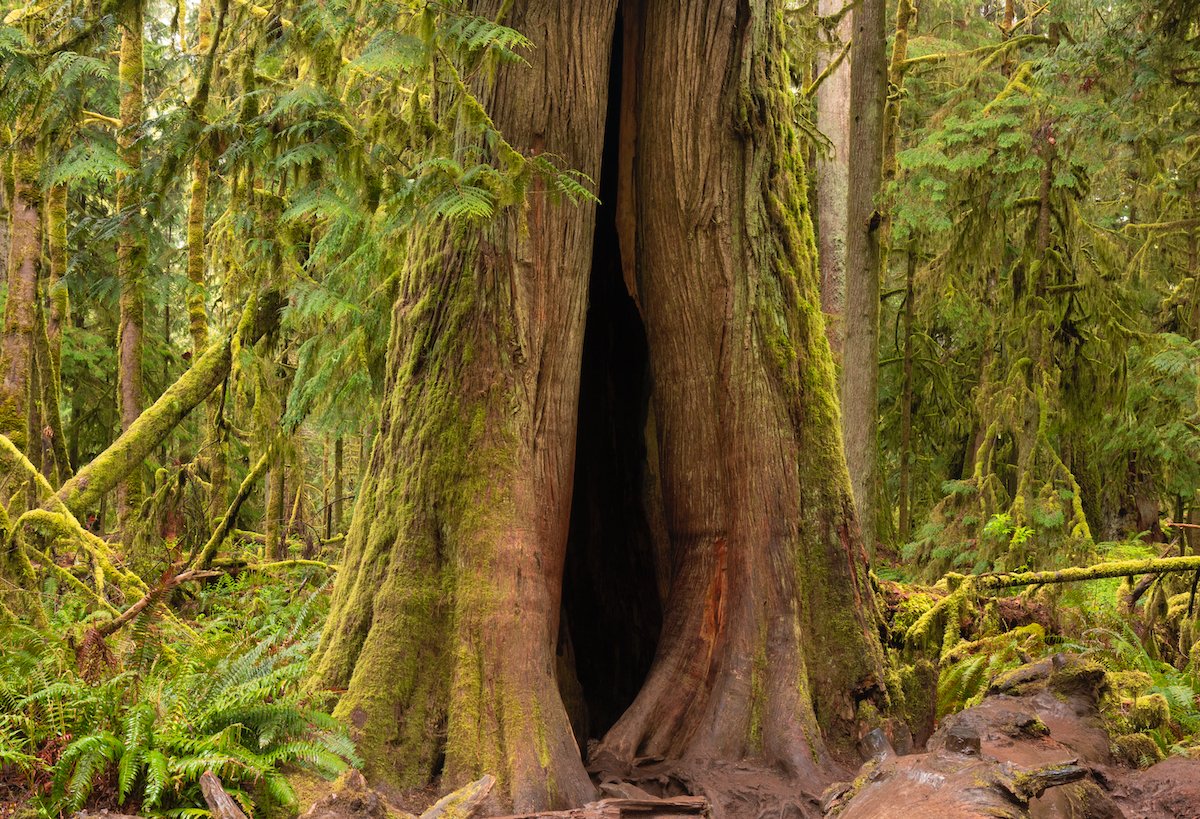Carmanah Walbran Provincial Park
Located in the southwestern section of Vancouver Island, Carmanah Walbran Provincial Park is perhaps the most remarkable and wildest big tree forest on Vancouver Island and in all of Canada. The park protects extensive tracts of luxuriant Pacific temperate rainforest and is famous for its ancient old-growth. Two valleys are of particular interest: the Carmanah Valley and the Walbran Valley, both of which contain trees of gigantic proportions.
Carmanah Valley Mist trail
The central trails of the Carmanah Valley wind through the most densely packed and spectacular spruce groves left on Vancouver Island. In the early 1990s, this remarkable valley served as ground zero for the conservation movement, resulting in a boardwalk trail that still exists today. Throughout its two round-trip miles, the Valley Mist Trail follows the Carmanah River closely, penetrating rain-soaked landscapes that are optimal for Sitka spruce old-growth.
Randy Stoltmann Commemorative Grove
Randy Stoltmann Commemorative Grove
The southern section of the Valley Mist Trail leads to both the Randy Stoltmann Commemorative Grove and the uniquely-shaped "Heaven Tree." Unfortunately, due to years of storm damage, the Stoltmann Grove is closed to visitation, but this magical place commemorates one of the most important conservationists in Vancouver Island’s history, whose relentless advocacy saved this and other valleys from destruction. The memorial is appropriate, as the grove contains one of the greatest concentrations of titanic Sitka spruces in the valley.
Coast Tower
Heaven Tree
Upper Carmanah valley Trail
The Upper Valley Trail, north of the boardwalk section, leads upstream through lush old-growth forests of primarily western hemlock, amabilis fir, and, of course, spruce. Several sections of the trail are lined with groves of huge trees. Because the path is not maintained north of the Valley Mist Trail, hikers must navigate significant blowdown. Though this slows hiking, the overgrown feel of the trail’s northern portion provides an unrivaled sense of adventure.
Several overnight backcountry camps, including Grunt’s Grove and Mystic Hollow, are accessible deep in the valley and remove hikers far from civilization. Near its end, about six miles from the parking lot, the trail reaches a stunning swimming hole of deep turquoise water named Paradise Pool. The landmark is an appropriate turnaround for day hikers. Further on, the trail fords the Carmanah River and continues north, though it becomes hard to discern. Here, the upper reaches of the valley offer hikers incredible solitude and true unspoiled wilderness.
Carmanah Paradise Pool
The Carmanah Valley is filled with big Sitka spruces and the largest known (pictured here) is located off-trail between Three Sisters and Grunt’s Grove.
Walbran valley
Known as both the "Walbran Solidarity Trail" and the "West Walbran Trail," the rough path into the Walbran Valley contains one of the best diversities of giant trees left on Vancouver Island. The trail begins near the Harriet Nahanee Memorial Trail and the Castle Grove Trail (described below), initially penetrating a forest of primarily western red cedar. Some of these giants are over 500 years old and have grown into incredible sizes and shapes with age. However, the best portion of the valley is the Sitka spruce groves that follow, including the ancient trees located near Giggling Spruce Camp and Fetus Lake.
The transition from western red cedar to Sitka spruce is quite remarkable and unique among the various trails in and around the Walbran Valley. One of the absolute largest of these spruces is "Maxine’s Tree," with a girth of over 12 feet in diameter that tapers very slowly up its 260-foot height. Further on, near Anderson Lake, the trail becomes a bit harder to follow, but it is worth the effort as huge trees grow ubiquitously in this astonishing valley.
Giggling Spruce Camp
Maxine’s Tree
Harriet Nahanee Memorial Trail
Opened in 2016, the Harriet Nahanee Memorial Trail commemorates the life and conservation efforts of a heroic First Nations woman who was instrumental in preserving both the Carmanah and Walbran rainforest valleys of southwestern Vancouver Island.
Starting by the shores of the Walbran River, the trail initially passes by several huge western red cedars, including the “Tolkien Giant,” before climbing steeply. The north side journeys through some equally gigantic, yet nameless, cedars that amazingly cling resiliently to the vertical slopes of this elevated hike.
Like other hikes in the Walbran Valley, the trail passes through cutblocks proposed by logging companies. By offering the public an opportunity to explore this ancient forest, the hike helps raise awareness of the danger these pristine giants face from short-sighted industry practices.
Emerald Loop Trail
The Emerald Loop Trail is the most accessible and family-friendly hike in the Walbran Valley. Situated parallel to the entry road into the valley, the trail is very short, fairly flat, and takes about 20 minutes to complete. Despite its brevity, the well-maintained boardwalk path takes hikers through an excellent old-growth environment where giant trees grow next to the Walbran River.
The trail was first forged in the early 1990s by protesters who dedicated considerable effort to bringing tourism into the area, thereby preventing further logging of the valley trees. As tourists began to arrive, conservationists built the boardwalk to mitigate the erosive damage heavy foot traffic would cause to the forest.
Castle Grove & Witness Trail
Few trails on Vancouver Island contain a higher concentration of monumental western red cedars than the magical Castle Grove. Located across the West Walbran Creek from the main Walbran Valley entrance, the Grove is situated on a rich alluvial flood plain—a perfect environment for the development of giant trees. The Grove’s largest specimen is the appropriately named "Castle Giant," which has grown to approximately 16 feet in diameter over hundreds of years.
On the eastern slopes above the Grove, conservationists have constructed a side path called the Witness Trail. Trees as large and tall as those in Castle Grove are found here as well. Forming a loop up a hill, the path is a thigh burner with an early vertical ascent no matter which direction you approach it. Like the Harriet Nahanee Memorial Trail, the route was strategically located to take hikers across proposed cutblocks by timber companies, helping draw attention to potentially devastating losses and encourage tourism over logging as the Walbran Valley’s main economic driver.
Castle Giant
meares island
Meares Island is among the three best giant tree hikes on Vancouver Island, alongside the Carmanah and Walbran valleys. At two miles in length, the "Big Tree Trail"—the only trail on the island still maintained—lives up to its moniker. An astonishing density of huge trees, particularly western redcedars, stand among its dense understory. Throughout its course, the trail circles the peninsula and moves through a mossy forest to reveal giant after giant.
Hanging Garden Tree
For about a third of the path, hikers are treated to a boardwalk that elevates above the forest floor. After the boardwalk ends, however, the trail drops into the muddy surface where a wet, sticky adventure begins. Because it requires boat or kayak access, the trail sees far fewer tourists than other hikes around Tofino. This enhances the experience, as the trail maintains its primitive, remote feel.
Despite its short length, I recommend taking time exploring this island. At least a solid half-day is required to immerse oneself in the character of this ancient, old-growth forest. This place is truly magical, and we have advocates from the First Nations community to thank for preserving it.
Poster Tree / Tree of Life
Pacific Rim National Park Reserve
Cheewhat Lake & Cheewhat lake Cedar
The forested perimeters of Cheewhat Lake contain several of Vancouver Island’s largest, record-breaking trees, and some of the biggest trees in British Columbia. For reference, Cheewhat Lake is tucked into the southern portion of Pacific Rim National Park Reserve. The lake is largely trail-less, but a few of the largest trees grow on the eastern end of the lake and can be accessed by the short Cheewhat Lake Cedar Trail. Though not officially recognized by Parks Canada, the trail is worn and fairly easily navigated. After initially dropping a few hundred feet to lake level, hikers encounter several giant trees, both standing and fallen.
Cheewhat Lake Cedar
Cheewhat Lake Cedar
The short 1.2-mile path weaves around the ancient forest through enormous trees and terminates at the world’s largest known western redcedar, the Cheewhat Lake Cedar. The girth of the Cheewhat Lake Cedar is measured at an astounding 18.34 meters (60 feet) and reaches a height of 55.50 meters (180 feet), containing 450 cubic meters of timber volume. The small grove near the Cheewhat Lake Cedar is perhaps the most striking, with several redwood-sized specimens.
For hikers seeking a bit more adventure, logging road T23B provides access to the northern portion of the lake, where a short bushwhack leads to an absolutely enormous tree that splits into two as one looks upward. This distinctly primordial-looking western redcedar is likely the result of fusion between two independently huge trees hundreds of years ago.
Highway 4
Highway 4 connects the eastern and western sides of Vancouver Island before running along the coast between Ucluelet and Tofino. Three roadside attractions are worth mentioning, along with Cathedral Grove, which is also profiled at the end of this guide.
The Canoe Creek Recreation Site, in the middle of the island, is a roadside gem and convenient stopover for those wishing to stretch their legs on the way to the coast. The Site protects a small grove of huge cedars, the largest of which is the Canoe Creek Cedar.
The Rainforest Trail, which is in Pacific Rim National Park Reserve, is an accessible introduction to the big tree forest environment of coastal Vancouver Island. The trail consists of loops north and south of the highway on well-maintained boardwalk that offers clean vistas. Both loops combine for a distance of approximately two miles, so it’s a nice detour or warm-up for longer or more primitive trails in the Tofino area.
Rainforest Trail
Canoe Creek Recreation Site
Canoe Creek Cedar
Third is the Ancient Cedars Loop Trail, close to the town of Ucluelet, a well-graded trail that takes you on a stroll among giant western red cedars and Sitka spruce, culminating with connection points to other trails that offer great views of the Pacific Ocean.
Ancient Cedars Loop Trail
Ancient Cedars Loop Trail
Clayoquot Arm Provincial Park
There exists a short but extraordinary big tree forest trail along the shores of Kennedy Lake near Clayoquot Arm Provincial Park. The road beyond the big tree trail has been closed for years, no longer allowing full access to the rest of the park, resulting in fewer visitors. The decreased foot traffic has led to slight neglect of the boardwalk around the big trees, but the trail is still very doable. A few of the trees here are more than 15 feet in diameter and contorted into fascinating shapes. When in Tofino, this is an area that one must explore.
Nitinat River Provincial Park (& Caycuse River)
Between Cowichan Lake and Nitinat Lake, travelers pass by two sections of a small provincial park protecting groves of verdant maple trees and spruces. The scenes here consist of beautifully lush and gorgeous forests flanking the Nitinat River as it gently meanders along its path. Another small patch of old-growth forest near Nitinat Lake and along the Caycuse River, is also worth exploring.
There are no official or maintained trails in this park or near the Caycuse River, and no directions on where to find huge trees. Instead, visitors need to explore off-trail and bushwhack their way around to discover them. The images featured here are a sample of the huge spruces found in these wild areas, far from urban development.
Shaw Creek Cedar
Port RenfRew
Avatar Grove
The increasingly popular Avatar Grove just north of Port Renfrew consists of two designated trails (upper and lower) passing through giant western red cedars and rare Douglas firs. Some of the oldest trees here have contorted themselves into really bizarre shapes and developed alien-looking burls and growths as they’ve aged over hundreds of years, making it one of Canada’s weirdest collections of trees. A highlight in the grove is "Canada’s Gnarliest Tree" — an ancient cedar with twisted wood. The trails were built (and their name was chosen) in an attempt to bring tourist attention to the area and prevent further logging.
Canada’s Gnarliest Tree
Eden grove
Aptly named, Eden Grove occupies the same river watershed as Avatar Grove and holds cedars of similar enormity. The trail is a simple and short out-and-back, ending at the largest cedar in the grove. A faint path through the shrubs beyond the official endpoint leads to the river below for a pleasant, longer walk.
Huge trees, scattered among their more plentiful, slender relatives, showcase the beauty of a truly ancient forest. As in Avatar Grove, some of the older trees have developed unique folds and contours that accentuate the maturity and age of these magnificent specimens.
Jurassic Grove
The wonderful cliffside forests south of Port Renfrew drop down to the gorgeous beaches along the wild western coast of Vancouver Island. Though the topography is steep, large trees thrive on these slopes and are nourished by the constant storms that originate from the ocean. Environmentalists have named a particular grove and built a short trail around it to promote its protection through public awareness. The cedars in this "Jurassic Grove" are extraordinary in height and width and still live in a fairly wild environment that is less developed than the nearby Avatar Grove.
Chin Beach Cedar
Fortress Giant
Port Renfrew
The small, sleepy town of Port Renfrew, British Columbia, has become the unofficial “big tree capital” of Vancouver Island (and all of Canada) by attracting tourists from around the world who seek to explore its nearby ancient forests. The town is partially known for a number of massive trees and groves that exist around its periphery. These behemoths are widely recognized as exemplary for their massive sizes. A few of these trees are worth mentioning, including the Red Creek Fir (the world's largest Douglas fir), the Harris Creek Sitka Spruce, Big Lonely Doug, and the San Juan Spruce (once Canada’s largest Sitka spruce).
Red Creek Fir
Harris Creek Sitka Spruce
San Juan Spruce
Cathedral grove (MacMillan Provincial Park)
The Island’s most famous big tree park is conveniently located right off Highway 4 just east of Port Alberni. Cathedral Grove in MacMillan Provincial Park could actually be considered two groves. To the north, the park protects a beautiful stand of stout western red cedars. At one point, the boardwalk that traverses the area elevates and offers a fantastic perspective into these ancient trees. To the south lies a grove of super tall Douglas firs for which the park is known. At more than 800 years old, these titans are stunningly large. A few plaques scattered throughout the grove mention the devastating 1997 New Year's windstorm that felled hundreds of big trees. Though the storm changed the park forever, the remaining trees are beautiful nonetheless.

